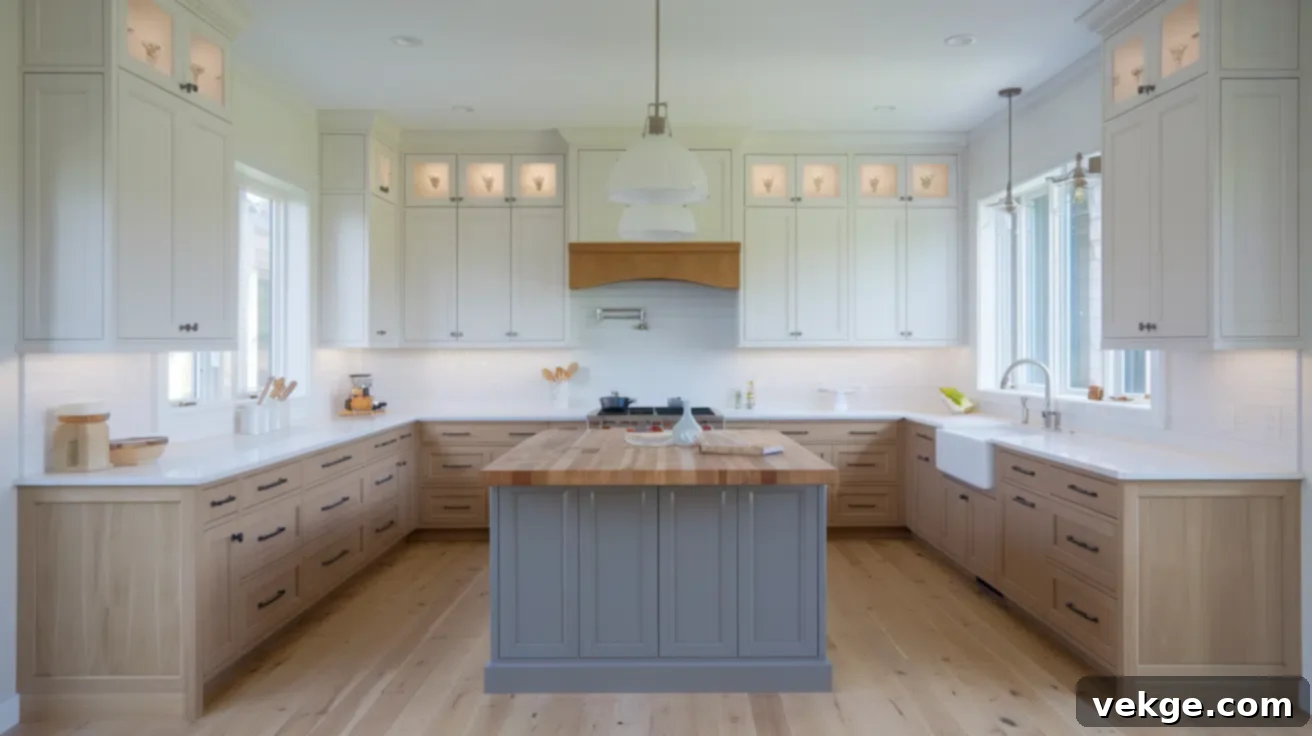Transform Your Kitchen: 30+ Stunning Two-Toned Cabinet Ideas & Expert Design Tips
Have you ever glanced at your kitchen and felt a subtle longing for something new, a refreshed look, but without the daunting prospect of a full-scale renovation? You are certainly not alone in this common homeowner dilemma.
Many homeowners seek to infuse their kitchens with a sense of modernity and vibrancy, desiring an updated feel without the significant commitment of tearing out and replacing everything. This is precisely where the timeless appeal of two-toned kitchen cabinets comes into play.
These versatile cabinet designs offer one of the most straightforward yet impactful ways to introduce contrast, achieve visual balance, and inject genuine personality into your cooking space, all without overcomplicating the design process.
In this comprehensive guide, we will explore a myriad of inspiring layout ideas, popular and subtle color combinations, and practical planning tips that are proven to work beautifully in real homes, just like yours. Whether your kitchen boasts a generous open layout or a more compact footprint, you’ll discover thoughtful solutions that seamlessly fit your specific needs and aesthetic preferences. Let’s embark on this design journey to uncover the perfect two-toned look that will best suit and elevate your unique kitchen space.
Why Two-Toned Cabinets Are a Practical and Smart Choice for Modern Kitchens
Two-tone kitchen cabinets offer a remarkable degree of flexibility and design versatility that single-color setups often lack. By thoughtfully mixing different shades and materials, you can introduce dynamic contrast and visual interest without making the space feel overwhelming or too busy.
This design approach is incredibly effective in kitchens of all sizes. For instance, employing lighter tones for upper cabinets can visually expand and brighten tight or compact areas, making them feel more open and airy. Conversely, deeper, more saturated tones on base cabinets can expertly anchor the design, providing a solid foundation and a sense of grounded stability.
Furthermore, two-toned cabinetry allows you to strategically highlight specific zones or architectural features within your kitchen, such as a prominent island, a cozy breakfast nook, or a dedicated pantry area. This focused accentuation can transform these elements into true focal points, all without necessitating a complete and costly remodel. The inherent layered look adds sophisticated structure and significant depth, making two-toned cabinets a highly functional, adaptable, and stylish choice that effortlessly integrates across a wide spectrum of interior design styles, from contemporary to classic.
Two-Toned Kitchen Cabinet Ideas to Inspire Your Kitchen Layout
Explore these diverse two-toned kitchen cabinet combinations, categorized to help you find the perfect aesthetic for your home.
Popular High-Contrast Combinations
These pairings make a bold statement, creating clear visual separation and modern appeal.
1. White and Navy Cabinets
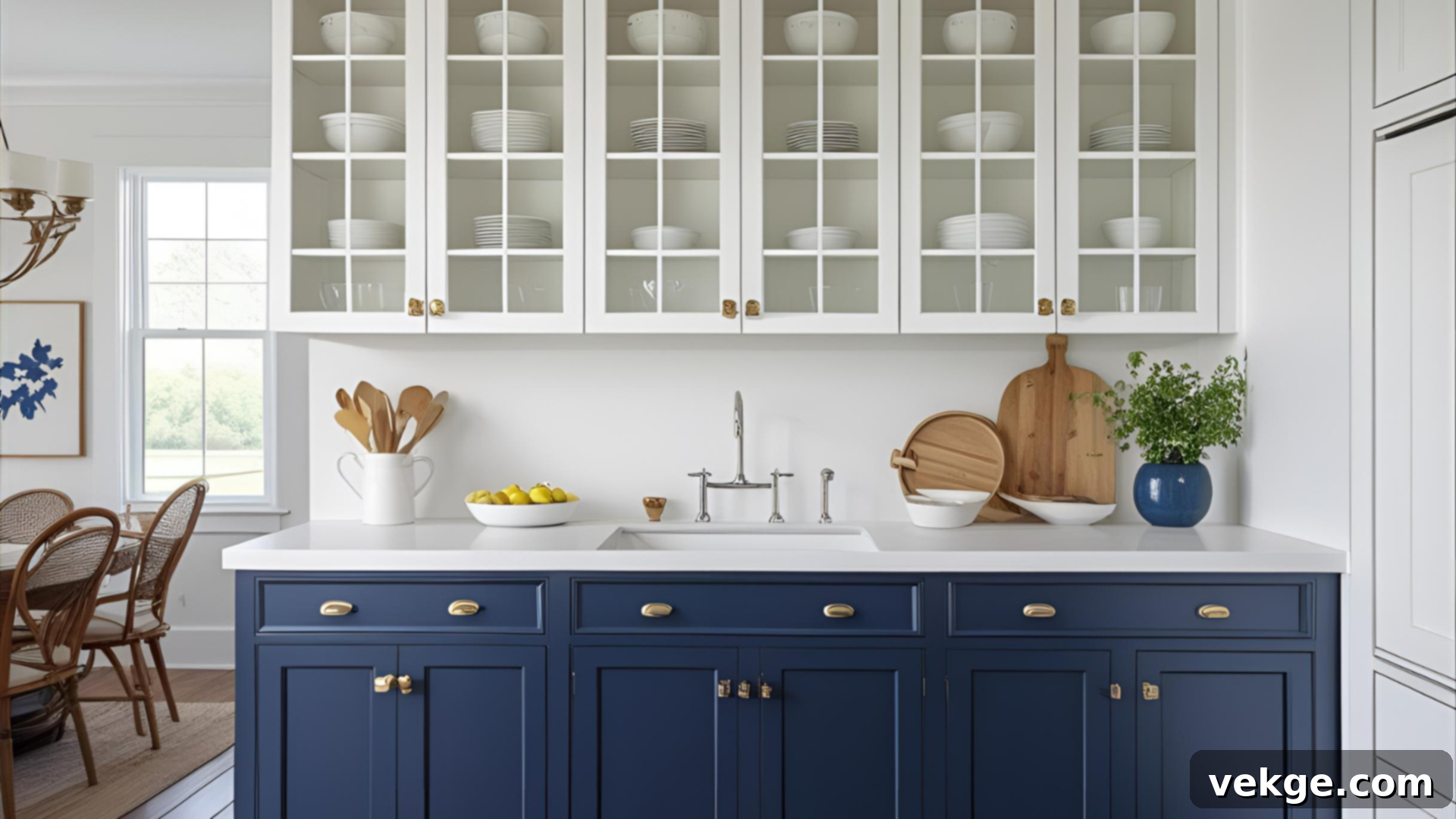
This classic pairing masterfully keeps the upper half of your kitchen bright and expansive, while grounding the space with rich, deep tones below. Navy base cabinets introduce a sense of sophisticated structure and elegance without dominating the room. The crisp, clean white uppers reflect light beautifully, making the entire kitchen feel more open and spacious, which is particularly advantageous in smaller kitchen layouts or those with limited natural light. Navy’s versatility also shines through its ability to perfectly complement various design elements, from warm wood floors to luxurious brass accents, offering ample flexibility when selecting fixtures and decor.
Design Tip: This combination is an excellent choice for kitchens with limited natural light or narrow layouts that benefit from visual depth without the need for dark walls. Consider polished nickel or matte gold hardware for an elevated finish.
2. Black and Woodgrain Cabinets

The striking juxtaposition of sleek black lower cabinets with the organic beauty of natural wood grain uppers creates a truly warm yet undeniably bold aesthetic. This high-contrast combination expertly divides the space visually, imparting a modern-meets-organic, industrial-chic feel. Practically, black cabinets are superb at concealing daily wear, fingerprints, and minor scuffs, making them a low-maintenance choice for high-traffic areas. Meanwhile, the rich textures and inherent warmth of woodgrain prevent the overall look from feeling too stark or cold, ensuring an inviting atmosphere.
Design Tip: This dynamic duo truly excels in open-plan kitchens or those blessed with abundant natural light, as it helps to balance the darker tones and maintain an airy ambiance. Pair with concrete countertops or minimalist hardware for a refined industrial touch.
3. White and Charcoal Gray Cabinets

Charcoal gray base cabinets lend significant weight and profound depth to the kitchen, creating a sophisticated and grounded look. Meanwhile, the pristine white uppers draw the eye upward, making the space feel taller and maintaining a bright, inviting atmosphere. This elegant combination achieves a clean, contemporary aesthetic without ever feeling sterile or monotonous. It harmonizes exceptionally well with cool-toned countertops like quartz or marble, and light-colored flooring, amplifying its sleek appeal. The forgiving nature of charcoal gray also means it effectively conceals minor scuffs, splashes, and daily wear, proving highly practical for busy kitchens.
Design Tip: This pairing is ideally suited for homes that embrace a modern, minimalist, or transitional design style, offering a chic and understated elegance. Consider integrated handle designs for an ultra-sleek finish.
4. Dark Blue Base, Cream Upper Cabinets
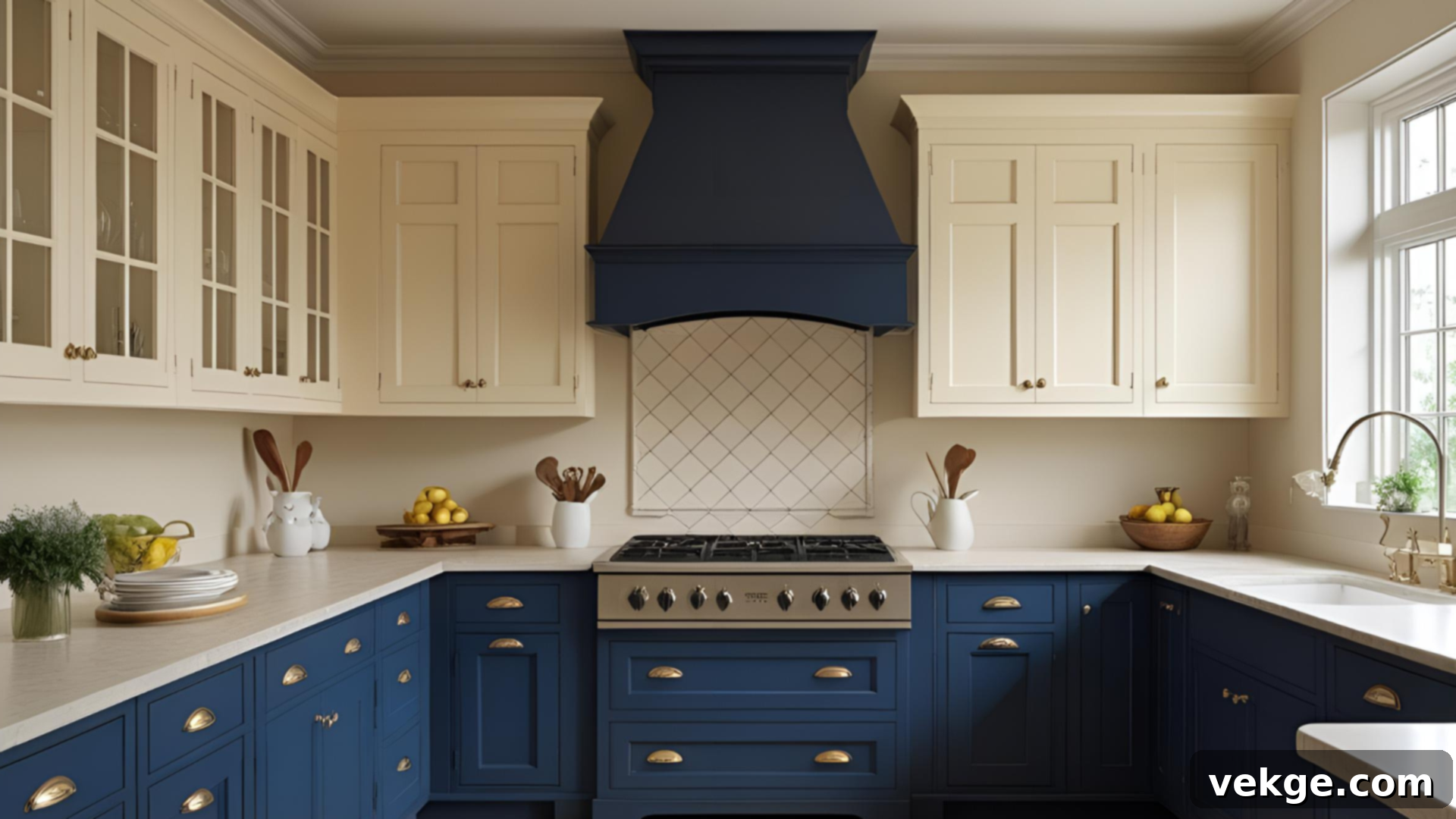
The deep, rich tones of dark blue infuse the base cabinetry with a sense of vibrant color and robust strength, providing a sturdy visual foundation. Complementing this, cream uppers gracefully soften the overall visual effect, adding a touch of warmth and classic elegance. This sophisticated combination delivers a timeless feel while possessing enough distinctive character to truly stand out. It serves as an excellent alternative to stark black if you desire significant contrast without venturing into overly bold territory. The warmth of cream ensures the space remains inviting.
Design Tip: This pairing looks particularly stunning with brushed nickel or elegant matte gold hardware, enhancing its classic appeal. It is well-suited for mid-sized or open-concept kitchens, where its depth can be fully appreciated.
5. Graphite and Light Oak Cabinets
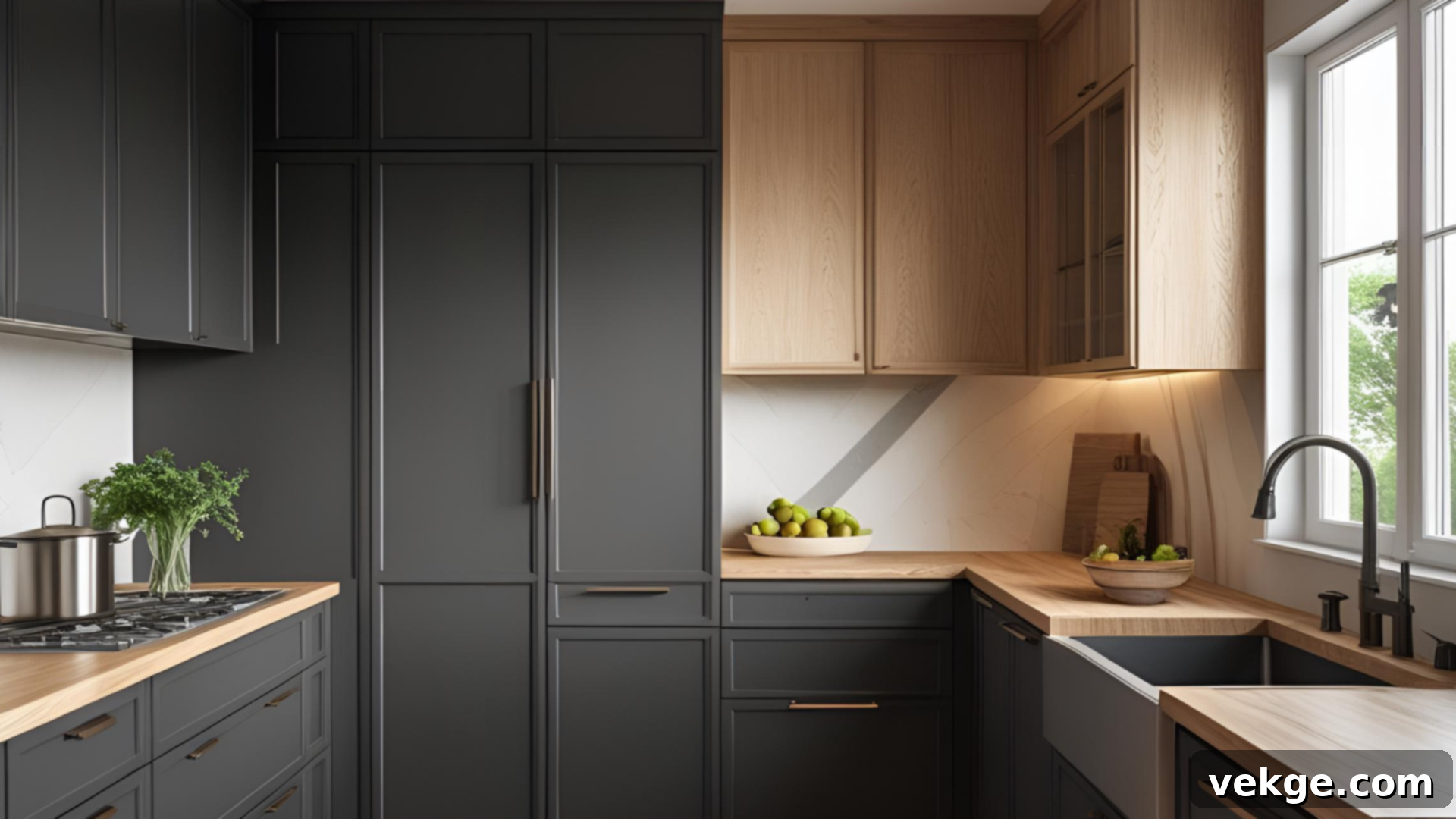
This striking pairing flawlessly balances sleek, contemporary design with warm, natural elements. Graphite cabinets introduce deep, sophisticated shadows and a modern edge, while light oak provides inviting warmth and essential texture through its visible grain. The clever variation in finish and material also simplifies the process of coordinating with mixed-material countertops, such as granite with natural wood accents or polished concrete. It stands as a particularly astute choice if you are aiming to combine state-of-the-art appliances with organic wood features for a cohesive and balanced modern kitchen.
Design Tip: For optimal visual impact, this combination is best utilized in kitchens featuring soft white or other neutral wall colors, which allow the cabinet tones to truly pop and provide a clean backdrop.
Soft Pairings for Subtle Style
These gentle combinations offer understated elegance and a harmonious flow, perfect for a serene kitchen atmosphere.
6. Warm Gray and White
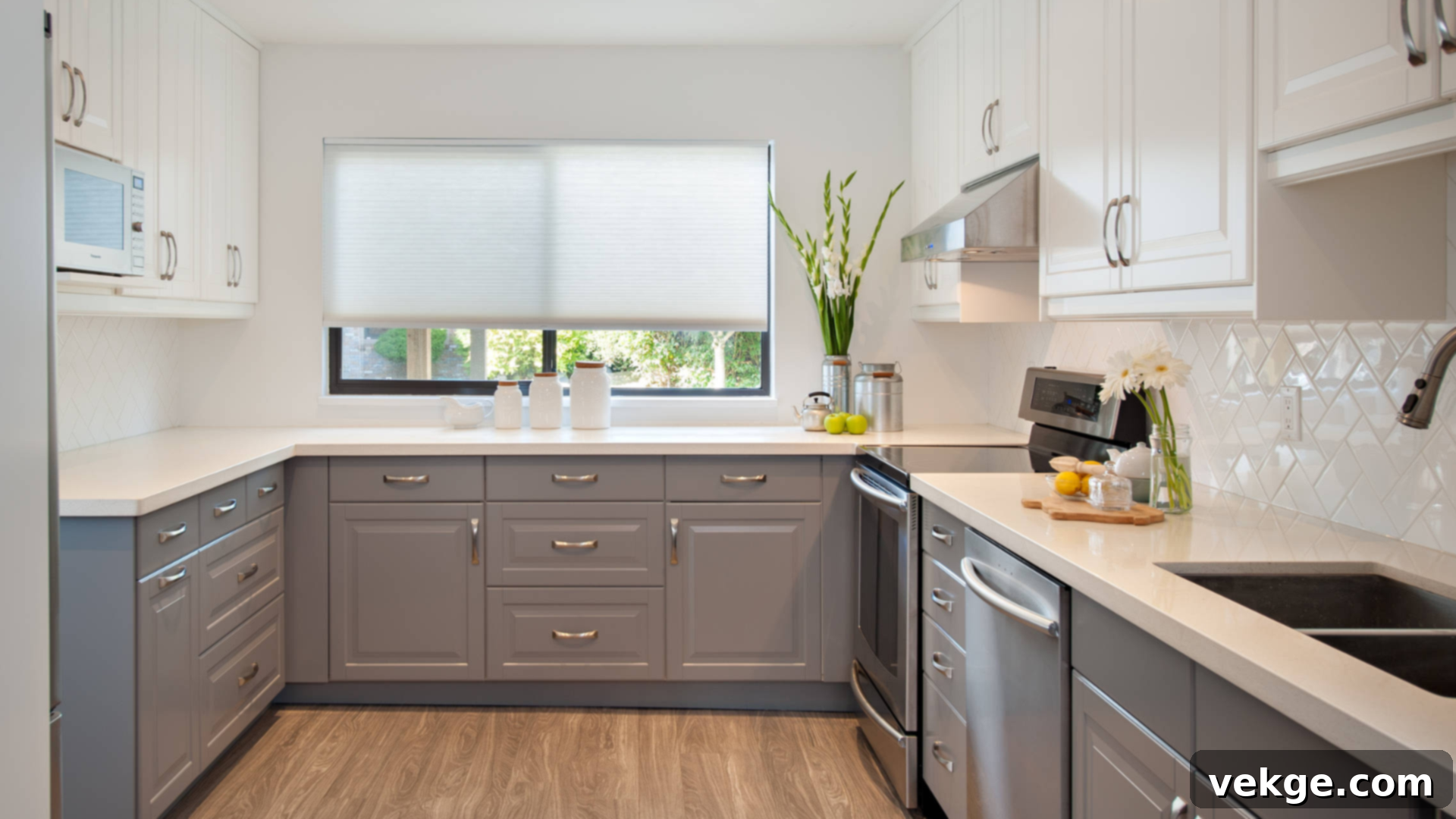
This subtle duo introduces just enough visual contrast to prevent the kitchen from appearing washed out or monotonous, while maintaining an undeniably serene palette. Warm gray lower cabinets blend smoothly with crisp white uppers, creating a sophisticated neutral base that is anything but boring. The inherent warmth in the gray tones makes it exceptionally easy to coordinate with complementary elements such as beige walls, natural wood finishes, or elegant brass fixtures, enhancing the inviting atmosphere. This timeless combination offers both style and practicality, effortlessly fitting into various design schemes.
Design Tip: This choice is ideal for households seeking a classic, low-maintenance aesthetic, particularly in medium-sized kitchens that benefit from a balanced lighting setup. It’s a safe yet stylish bet for broad appeal.
7. Pale Blue and Ivory
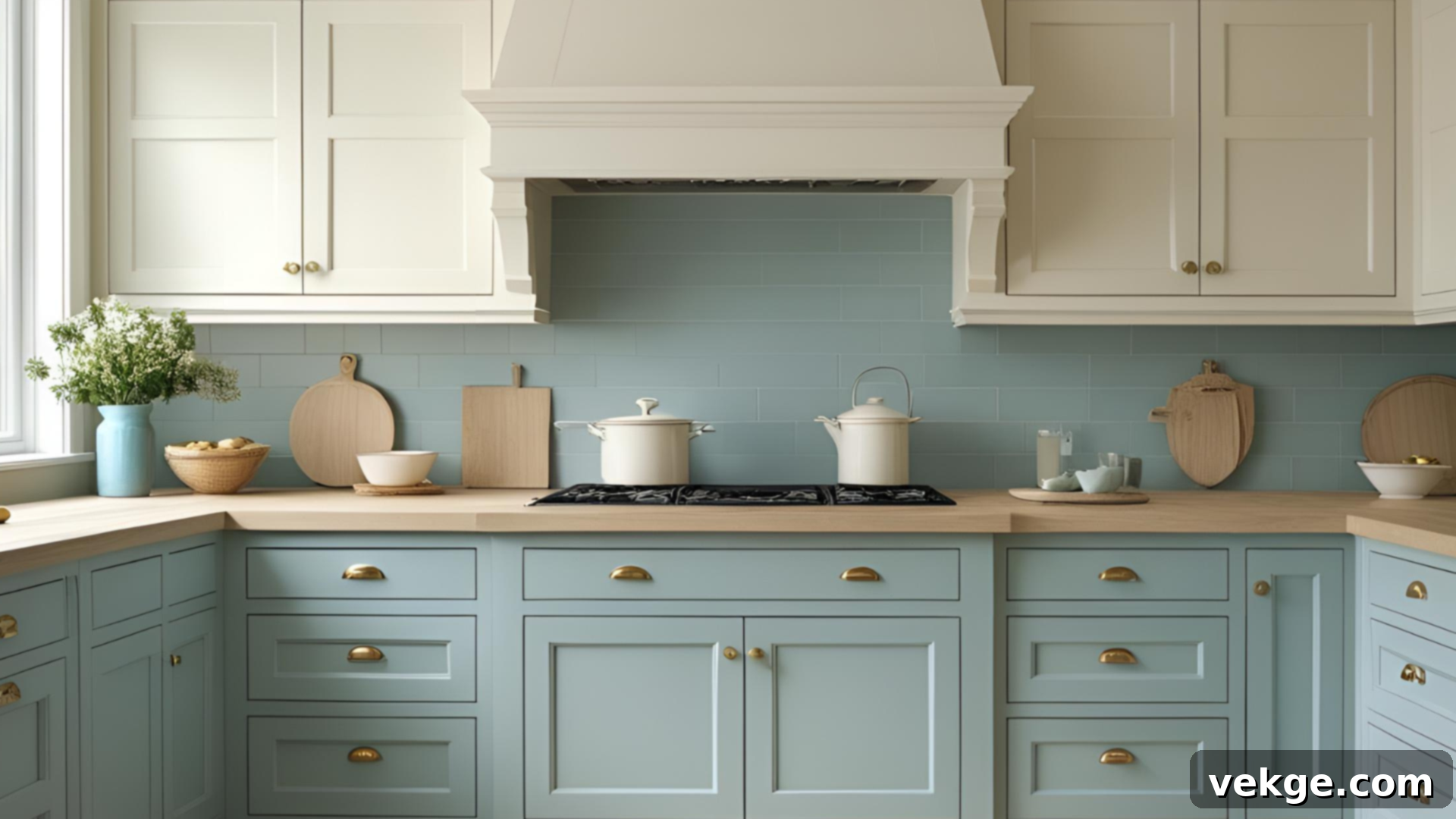
This delightful combination evokes a sense of serene calm and understated elegance, making any kitchen feel instantly more welcoming. Pale blue on the lower cabinets introduces a gentle touch of color without ever overwhelming the space, providing a soothing, muted base. Ivory uppers gracefully soften the overall visual tone, reflecting light and contributing to an airy, expansive feel. It represents a low-risk, high-reward pairing for individuals who desire a hint of color in their kitchen but are hesitant to commit to strong, high-contrast schemes. The result is a harmonious and comforting environment.
Design Tip: This particular combination flourishes in coastal, country, or farmhouse-style kitchens, especially those that benefit from an abundance of natural light. Complement with rustic wood accents or linen textures.
8. Beige and Greige
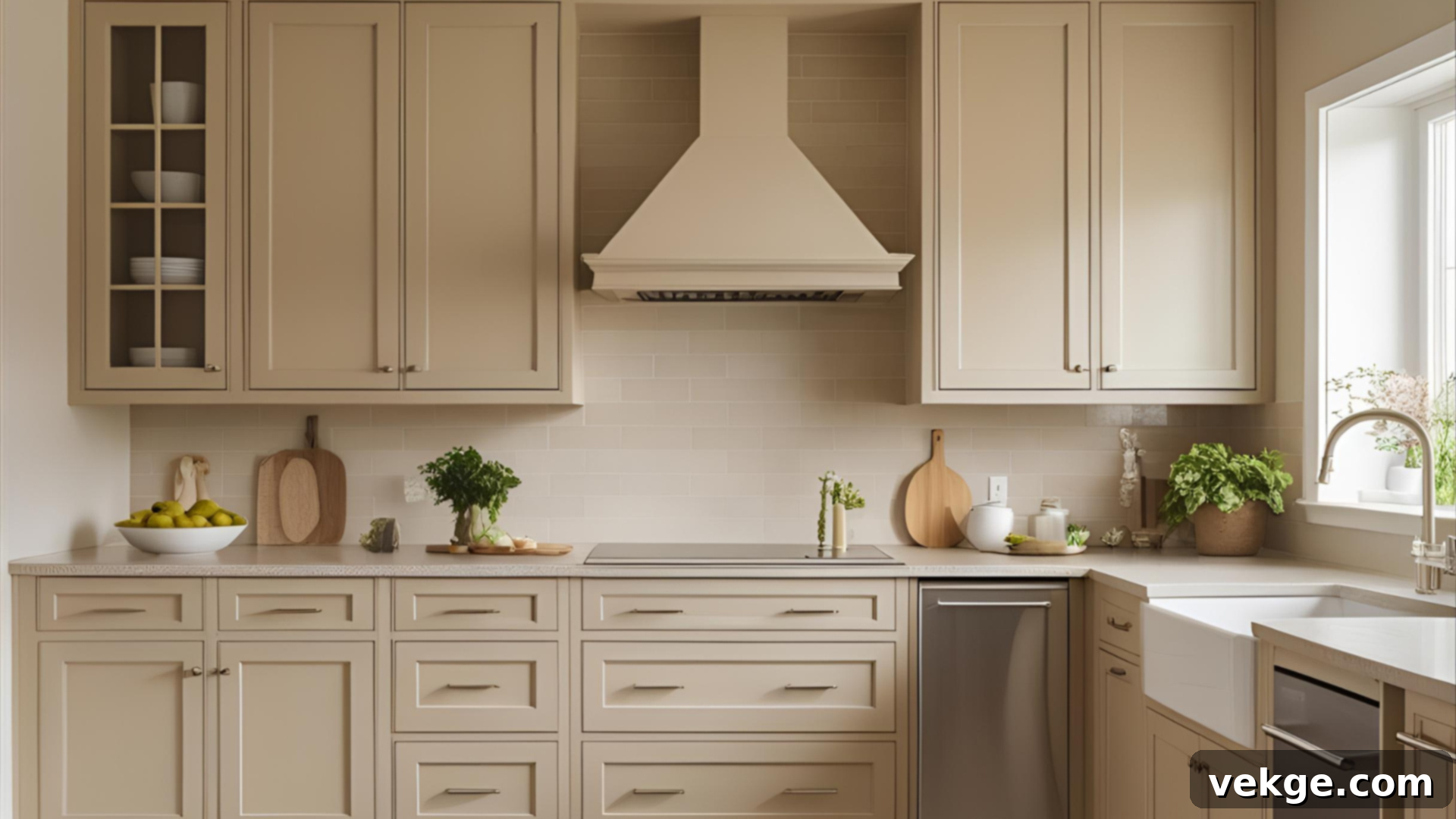
The thoughtful pairing of beige base cabinets with greige (a blend of gray and beige) uppers creates a beautifully layered and sophisticated neutral palette. The subtle yet distinct variation between these two tones prevents the space from feeling overtly flat or monotonous, while simultaneously ensuring ease of coordination with other finishes, materials, and decor elements. This combination is inherently warm, relaxed, and supremely practical, making it an excellent choice for anyone who wishes to steer clear of pure white cabinets but still desires a clean, refined, and inviting base for their kitchen design.
Design Tip: This neutral yet dynamic duo is a fantastic fit for kitchens featuring warm wood flooring, natural stone countertops, or soft metallic hardware, creating a cohesive and earthy ambiance.
9. Sage Green and Bone White
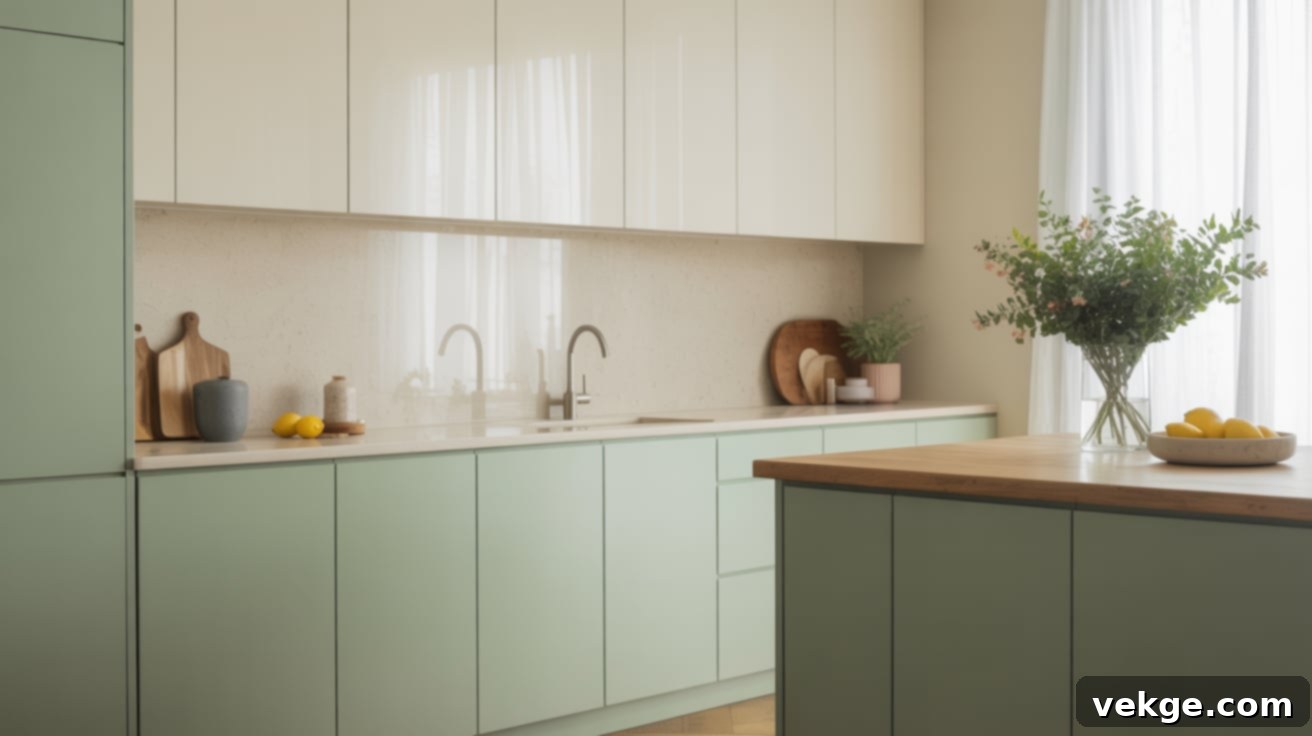
Sage green on the lower cabinets introduces a wonderfully soft, organic, and natural touch to the kitchen, bringing a calming presence to the heart of the home. Bone white uppers, with their subtle warmth, effectively help to reflect light, brightening the space and making it feel more open. This combination is exceptionally easy on the eyes, creating a tranquil and inviting atmosphere. It pairs harmoniously with a variety of mixed materials, such as the rustic charm of butcher block countertops or the refined elegance of quartz, offering a versatile foundation for diverse styles. Sage green provides just enough gentle contrast without ever becoming overly bold or dominant.
Design Tip: This pairing is a fantastic choice for kitchens that require a gentle infusion of color to feel more alive and personal, without the risk of appearing cold, overly sterile, or too tied to transient trends. Excellent for a fresh, earthy vibe.
10. Light Taupe and Natural Birch

The light taupe base cabinets introduce a wonderfully warm, earthy, and sophisticated tone, creating a solid and inviting foundation in the kitchen. Above, natural birch cabinetry adds bright lightness and a subtle, appealing woodgrain finish, preventing the space from feeling too heavy or uniform. This thoughtful pairing ensures the kitchen feels both grounded and impeccably organized. The airy and neutral quality of birch makes the entire layout remarkably easy to update or personalize later with seasonal accessories, paint, or new hardware, ensuring long-term adaptability.
Design Tip: This combination is perfectly suited for homes that feature warm lighting and embrace transitional cabinetry styles, offering a harmonious blend of natural beauty and understated elegance. Consider white or cream quartz countertops for a fresh finish.
Natural Wood + Painted Cabinets
Combining the timeless beauty of natural wood with the versatility of painted finishes creates kitchens that are both rich in texture and personalized in color.
11. Walnut and Off-White
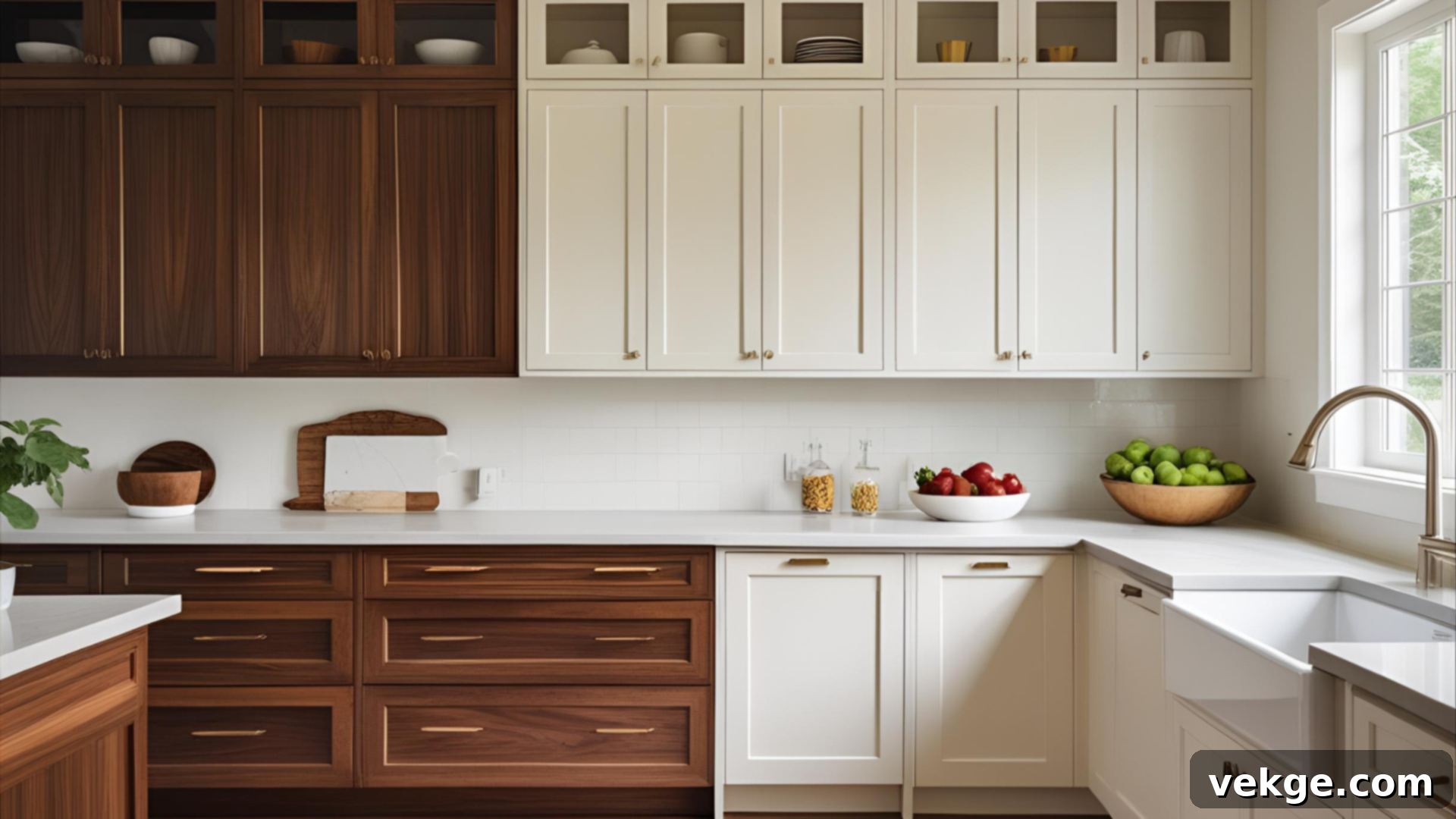
Dark walnut base cabinets imbue the kitchen with a profound sense of richness, luxurious depth, and grounded weight, establishing a commanding presence. In contrast, the off-white uppers gracefully maintain brightness and balance, preventing the darker tones from overwhelming the space. The exquisite combination of these two distinct finishes forges a well-rounded and harmonious design that feels both stable and expansively open. Walnut’s deep hues are exceptional at concealing daily wear and tear, while off-white offers incredible versatility, pairing effortlessly with a vast array of hardware finishes, from polished chrome to antique bronze.
Design Tip: This sophisticated pairing is ideally suited for larger kitchens or open-concept homes that benefit from clear visual zoning between prep areas and wall-mounted storage. It adds a touch of classic elegance and functionality.
12. White Oak and Soft Green
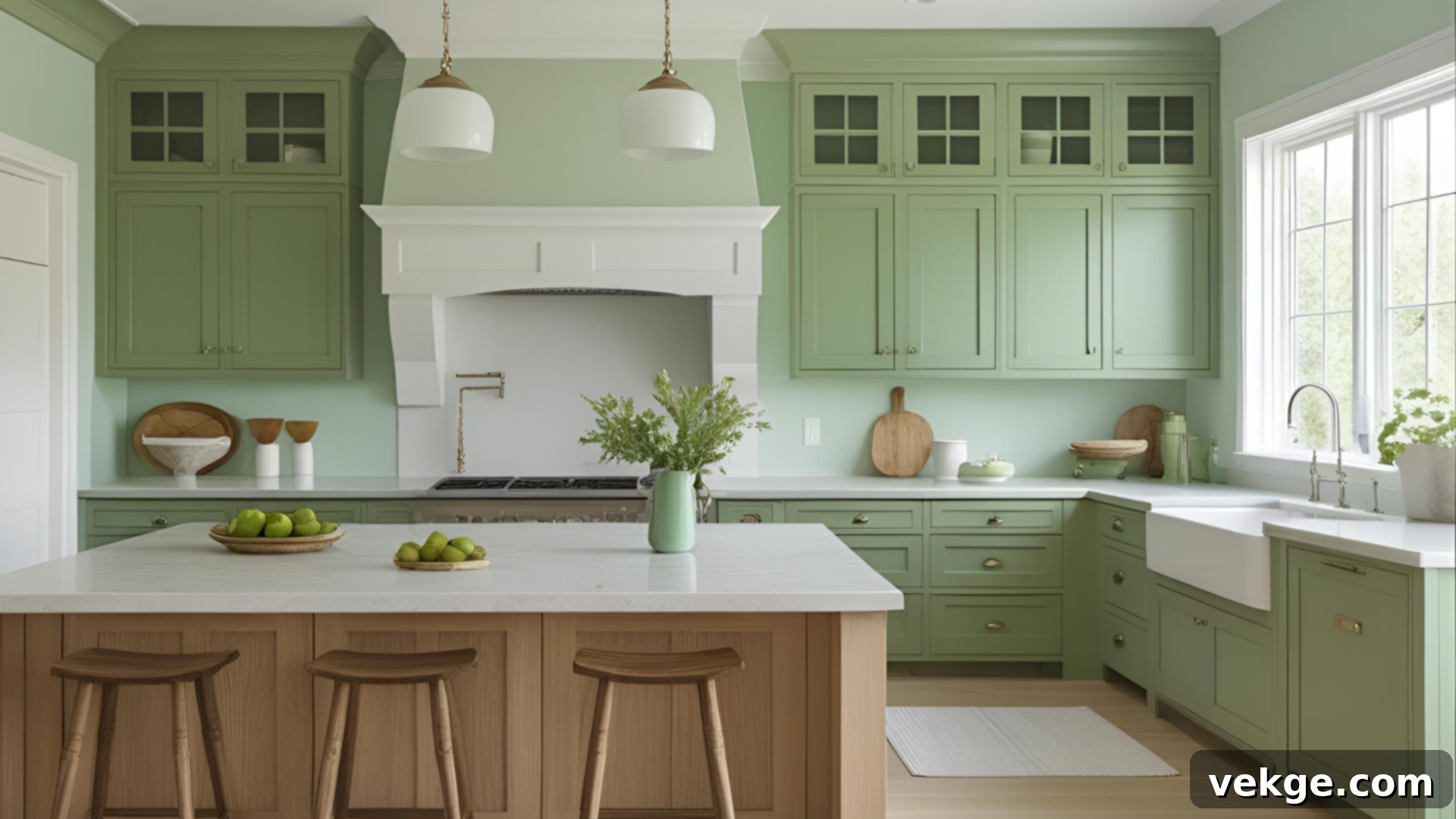
White oak introduces exquisite texture and organic depth, with its characteristic grain adding visual interest to the kitchen. Complementing this, soft green provides a subtle, calming burst of color that evokes a sense of nature and tranquility. Together, they offer a refreshingly modern take on kitchen design that is engaging without being distracting. The inherent warmth of the oak tones beautifully harmonizes with cooler green hues, ensuring a balanced and inviting palette. This combination also blends effortlessly with various countertop materials, from classic white marble to natural stone, offering broad design flexibility.
Design Tip: Opt for this combination in kitchens where you desire a calm, nature-inspired color base, allowing the beauty of natural materials to truly shine through. Ideal for Scandinavian or contemporary farmhouse styles.
13. Maple and Slate Gray
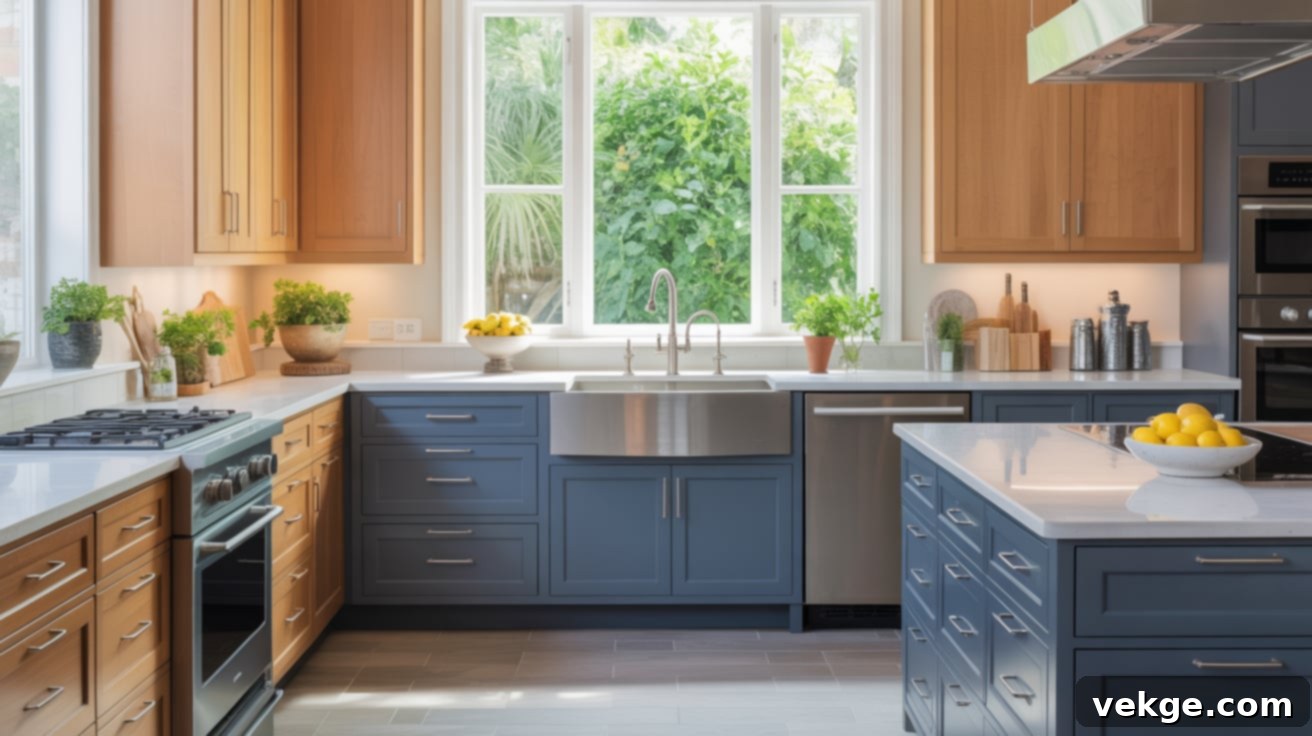
The bright, clean tone of maple wood expertly softens the inherent boldness and depth of slate gray cabinets, creating a balanced and sophisticated contrast. This dynamic pairing offers significant design flexibility, allowing you to lean towards a modern, sleek aesthetic or a more traditional, refined look, largely depending on your choice of hardware and overall kitchen layout. Maple is known for its durability and smooth finish, while slate gray offers a contemporary edge. Both finishes are also remarkably easy to clean and resist fading, ensuring lasting beauty and practicality in a busy kitchen environment.
Design Tip: This combination is optimally utilized in homes that feature mixed metal accents and matte finishes on walls or backsplashes, enhancing its contemporary appeal. Consider brushed stainless steel or black hardware for a chic touch.
14. Driftwood Base with Arctic White Uppers
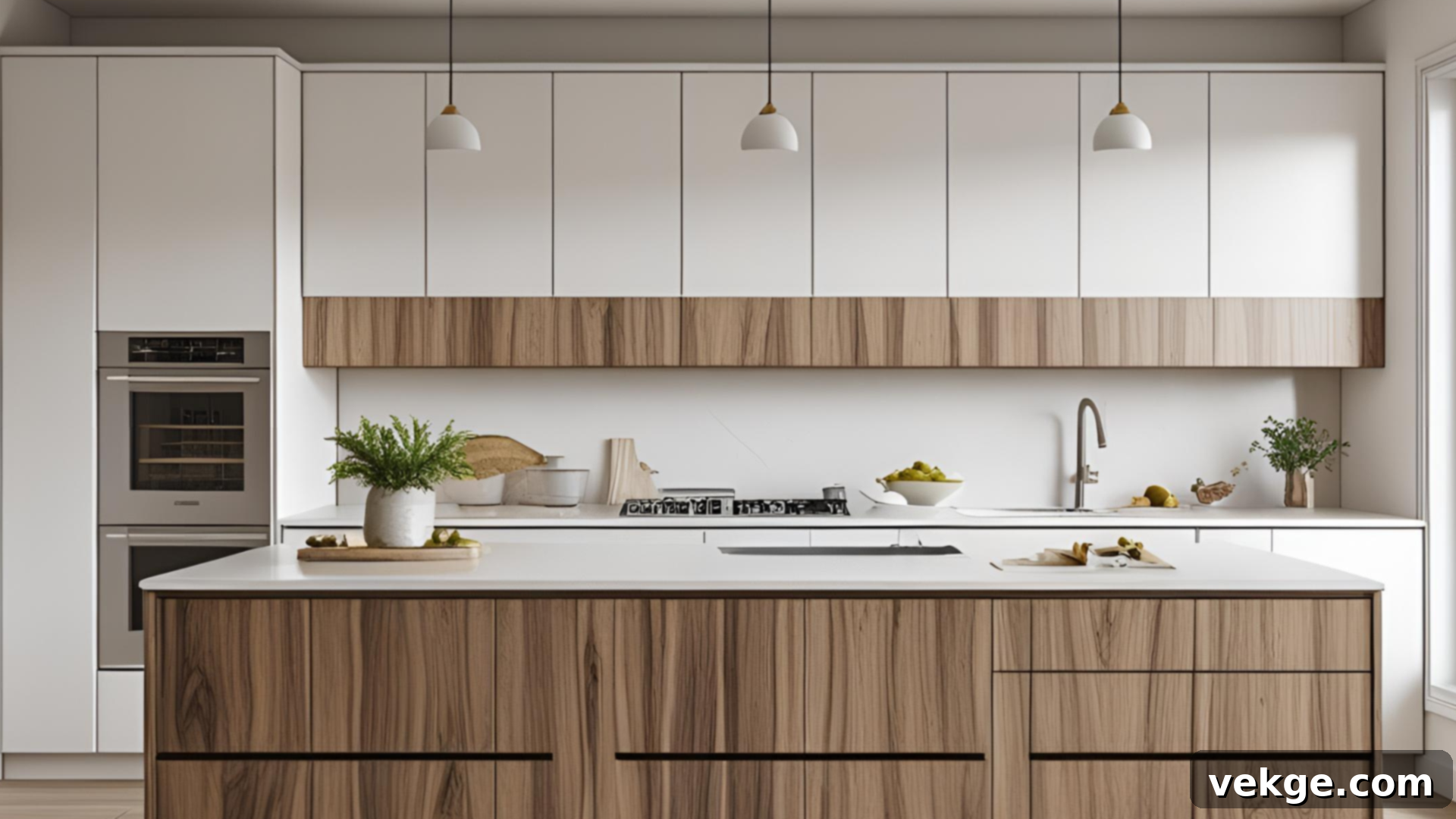
The gentle, weathered grain of driftwood base cabinets introduces a beautiful, tactile texture and an organic, coastal-inspired charm to the lower half of your kitchen. Meanwhile, arctic white uppers bring a sense of crisp clarity and pristine brightness to the upper sections, ensuring the space feels open and airy. The overall aesthetic is one of serene balance, making it an excellent choice for open kitchens where you want the lower cabinets to complement rather than overpower the room. This pairing creates a relaxed, sophisticated atmosphere, subtly hinting at natural elements without being overtly rustic.
Design Tip: This combination is perfectly suited for minimalist kitchens, coastal-inspired designs, or open-plan spaces that benefit from abundant natural light. Pair with light quartz countertops and simple brushed chrome hardware for a cohesive look.
15. Rustic Cherry and Almond
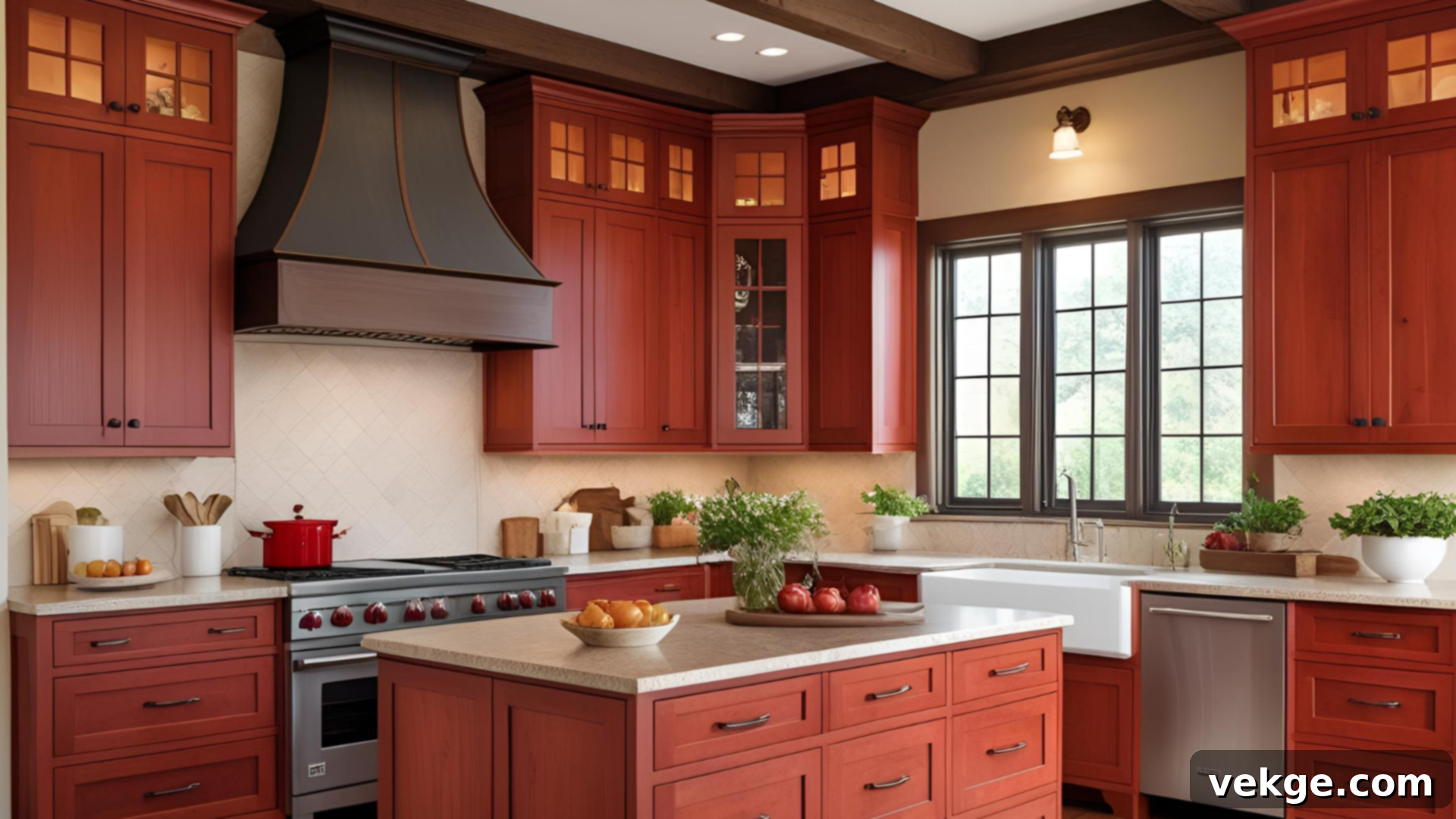
Rustic cherry base cabinets proudly display their beautiful, natural red undertones and rich grain, injecting warmth and character into the kitchen’s foundation. Complementing this, almond uppers gracefully soften the visual impact, ensuring the space remains inviting and balanced, rather than overly dark. This charming blend works exceptionally well in transitional or craftsman-style kitchens, where natural materials and a sense of enduring quality are celebrated. The deep tones of cherry are also highly practical, adeptly hiding daily wear and tear, and reducing the frequency of demanding cleaning, making it a functional and aesthetically pleasing choice.
Design Tip: This combination is ideal for kitchens with warm or golden lighting, where deeper tones benefit from softening at eye level to prevent the space from feeling too enclosed. Pair with classic bronze or copper hardware for a harmonious look.
Two-Tone Kitchen Islands and Accents
Harness the power of two-tone design by using a contrasting color for your kitchen island or specific accent areas.
16. Dark Island with White Perimeter
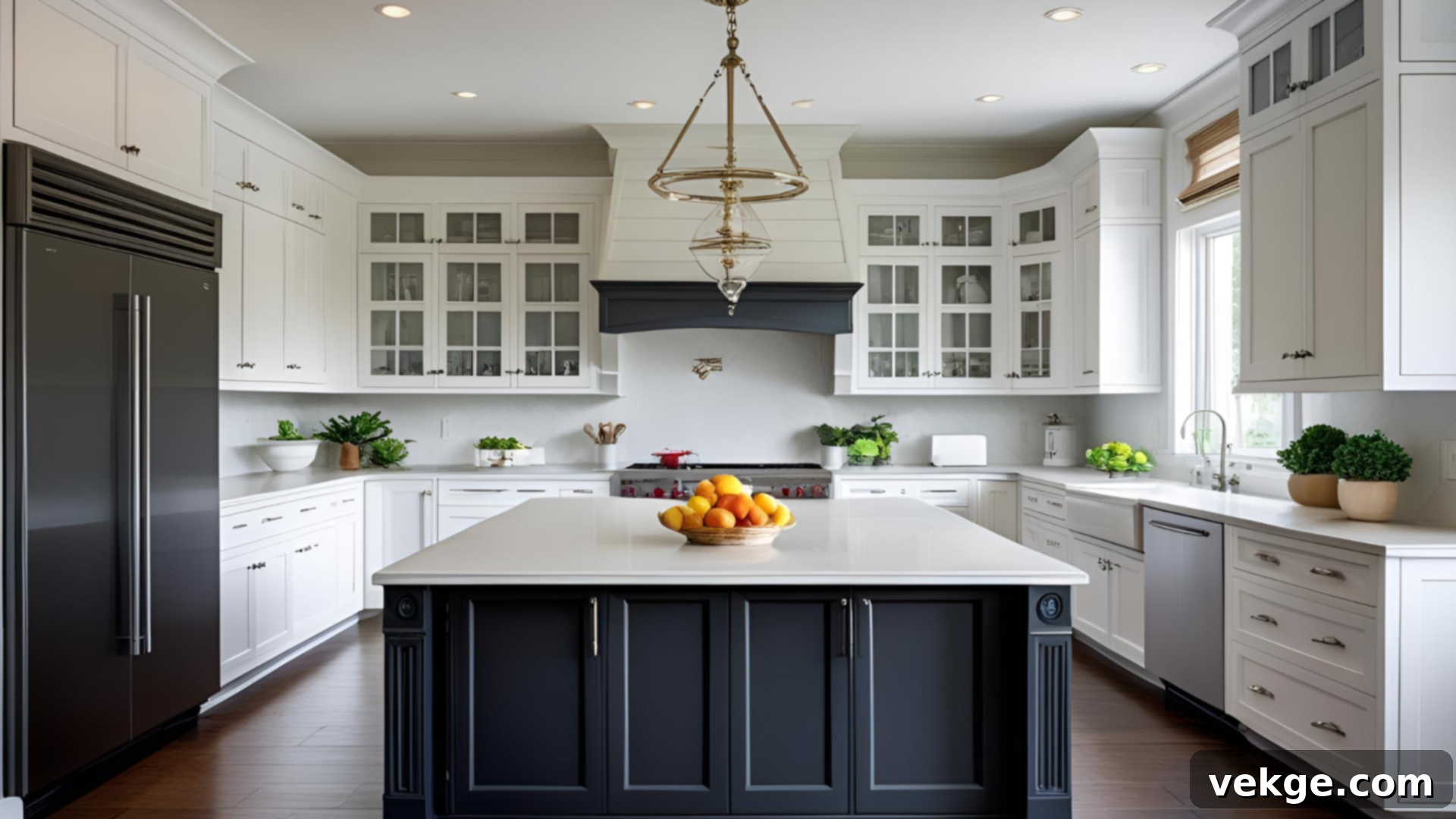
A striking dark-toned island serves as a powerful anchor for the entire kitchen space, naturally distinguishing the central prep zone from the surrounding areas. The perimeter cabinets, finished in crisp white, ensure the rest of the room maintains a feeling of lightness, openness, and impeccable organization. This clever pairing elevates the island to a significant visual focal point, drawing attention to its functionality and style, while still offering creative freedom with backsplash choices, flooring materials, and decorative elements. It’s a sophisticated way to add depth and structure.
Design Tip: Implement this layout in open kitchens or shared cooking/dining areas to subtly but effectively divide functional zones without the need for extensive structural changes or new floor plans. Consider a waterfall edge countertop on the island for a truly luxurious look.
17. Green Island in a White Kitchen
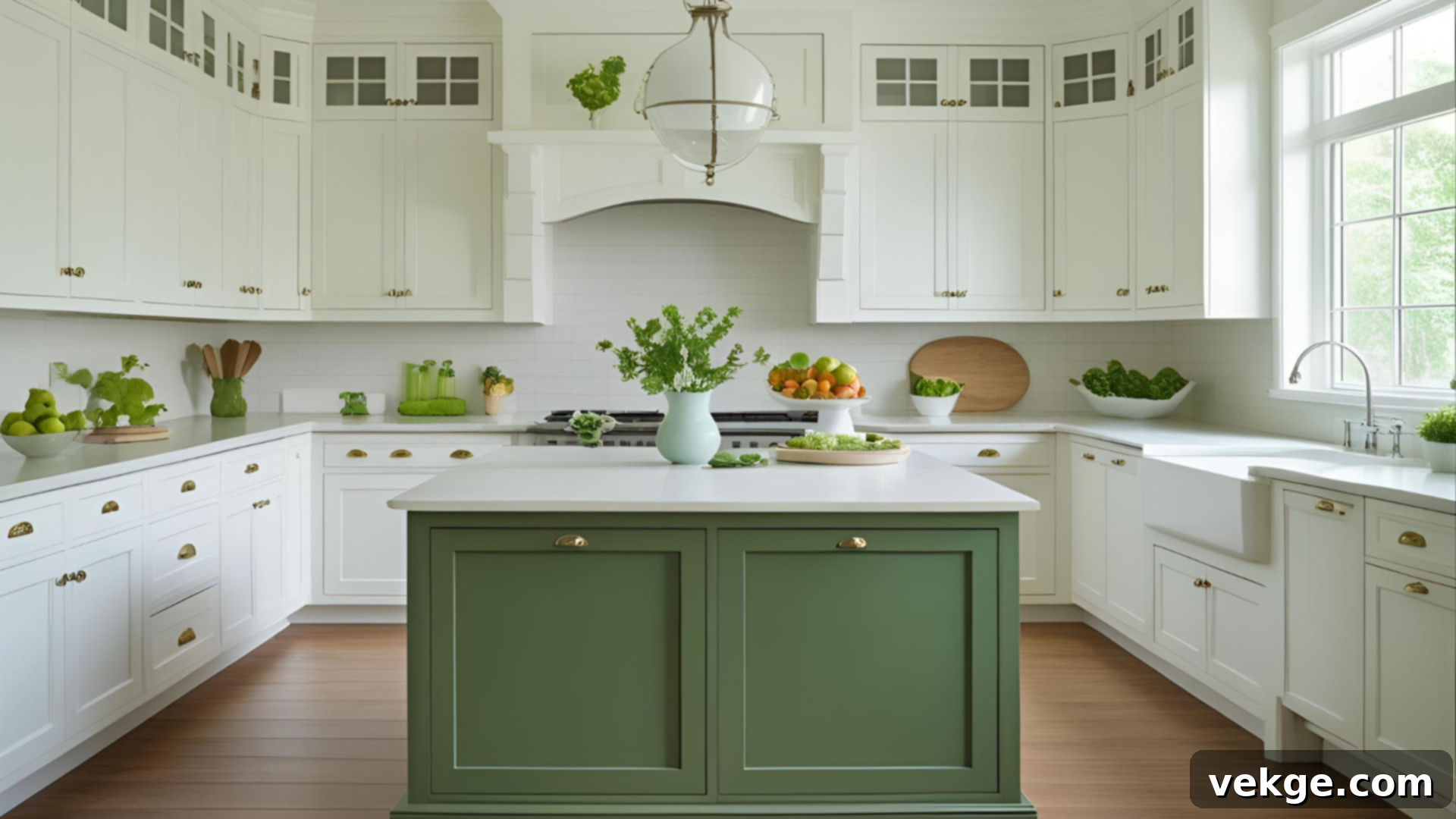
A soft or deep green island introduces a delightful pop of natural color and captivating interest into an otherwise pristine white kitchen, without ever dominating the overall aesthetic. The surrounding white cabinetry ensures the entire space remains clean, bright, and wonderfully straightforward, allowing the green island to truly shine as a purposeful and inviting centerpiece. This design strategy offers a low-commitment yet highly effective way to infuse vibrant color into your kitchen, providing a refreshing focal point that can be easily updated or re-styled over time. Green hues bring a calming, organic touch.
Design Tip: Enhance this setup in kitchens by incorporating elegant gold or warm bronze hardware, which will beautifully complement the green island and add an extra layer of warmth and sophistication. Consider an earthy quartz or butcher block countertop.
18. Black Cabinetry With Lighter Cabinets Full-height
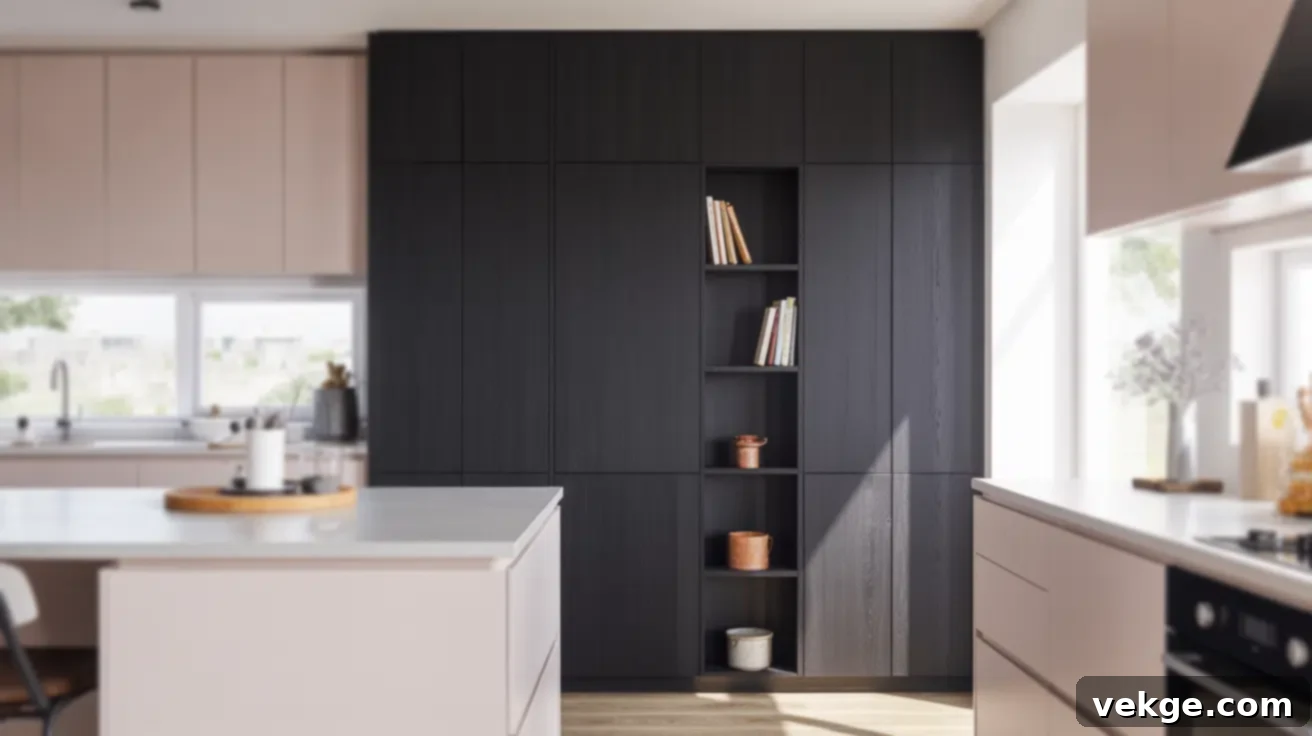
Strategically placing black cabinetry along a full-height pantry wall instantly infuses the kitchen with dramatic depth, sophisticated presence, and a touch of modern luxury. This bold feature is elegantly balanced by lighter base and upper cabinets elsewhere in the room, preventing the space from feeling too heavy or enclosed. This dark accent wall serves as an impeccable backdrop for open shelving displaying cherished dishware, or a dedicated display zone for art or culinary books, adding visual interest and functionality. It creates a defined architectural element within the kitchen.
Design Tip: This approach works most effectively in wider kitchens or those with high ceilings, where the vertical visual weight of the black cabinetry will enhance rather than overwhelm the overall layout. Consider matte black hardware for a seamless, contemporary look.
19. Gray Built-In Hutch in a White Layout
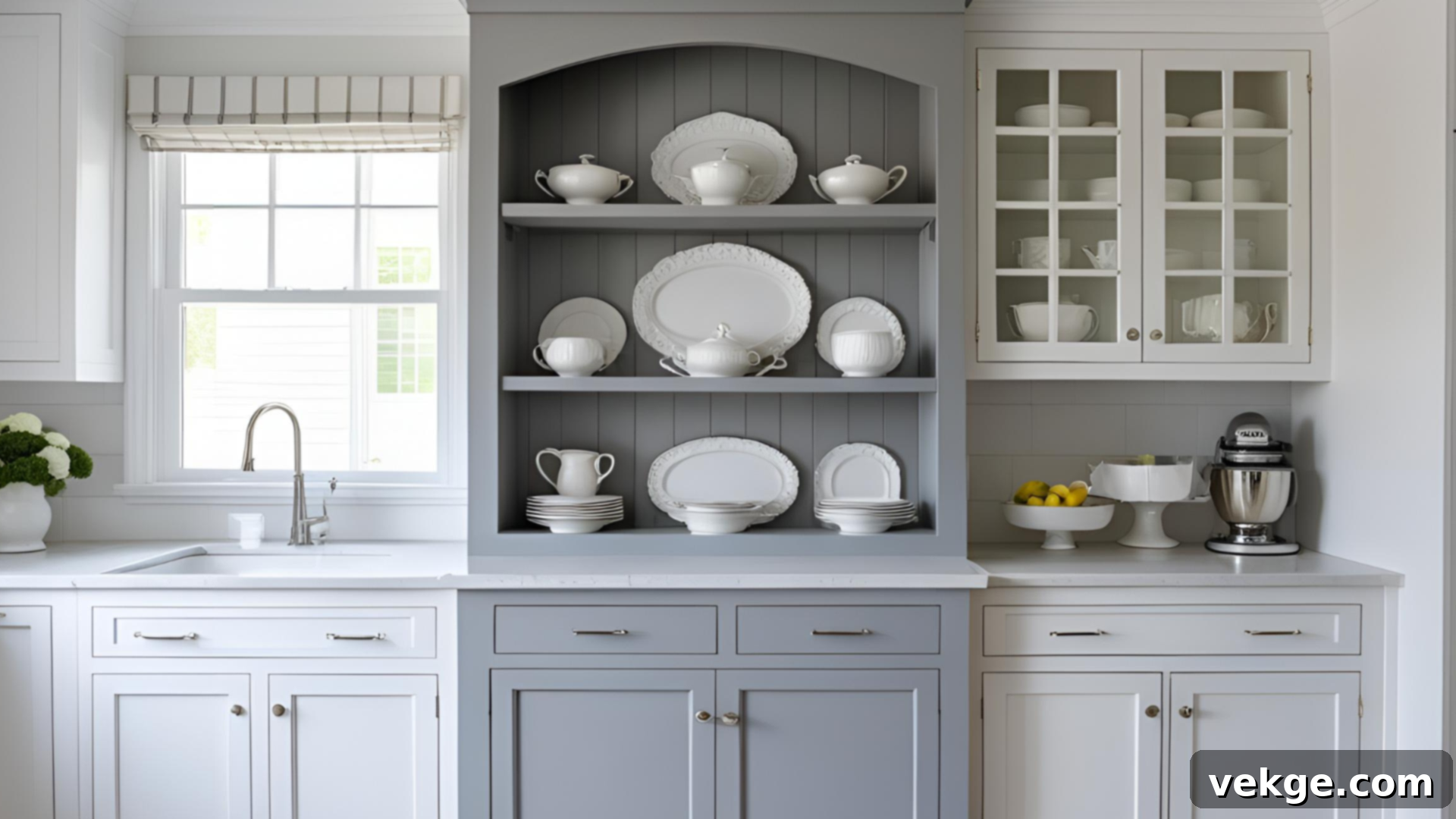
Integrating a gray built-in hutch into an otherwise white kitchen layout adds subtle dimension and sophisticated character without ever overpowering the space. This thoughtful accent breaks up the potential monotony and repetition of an all-white cabinet scheme, creating a distinct visual break. It functions beautifully for artfully displaying cherished dishware, glassware, or for efficiently storing dry goods and small appliances. The gentle shift in color, from white to a complementary gray, is sufficient to create visual interest and definition, yet it still blends harmoniously with the light, airy scheme, ensuring a cohesive and elegant look.
Design Tip: This design element is ideal for traditional layouts or kitchens that thoughtfully open into dining rooms, providing a seamless transition and an additional area for display or storage. Consider fluted glass inserts for a timeless touch.
20. Wood Island with Painted Cabinets
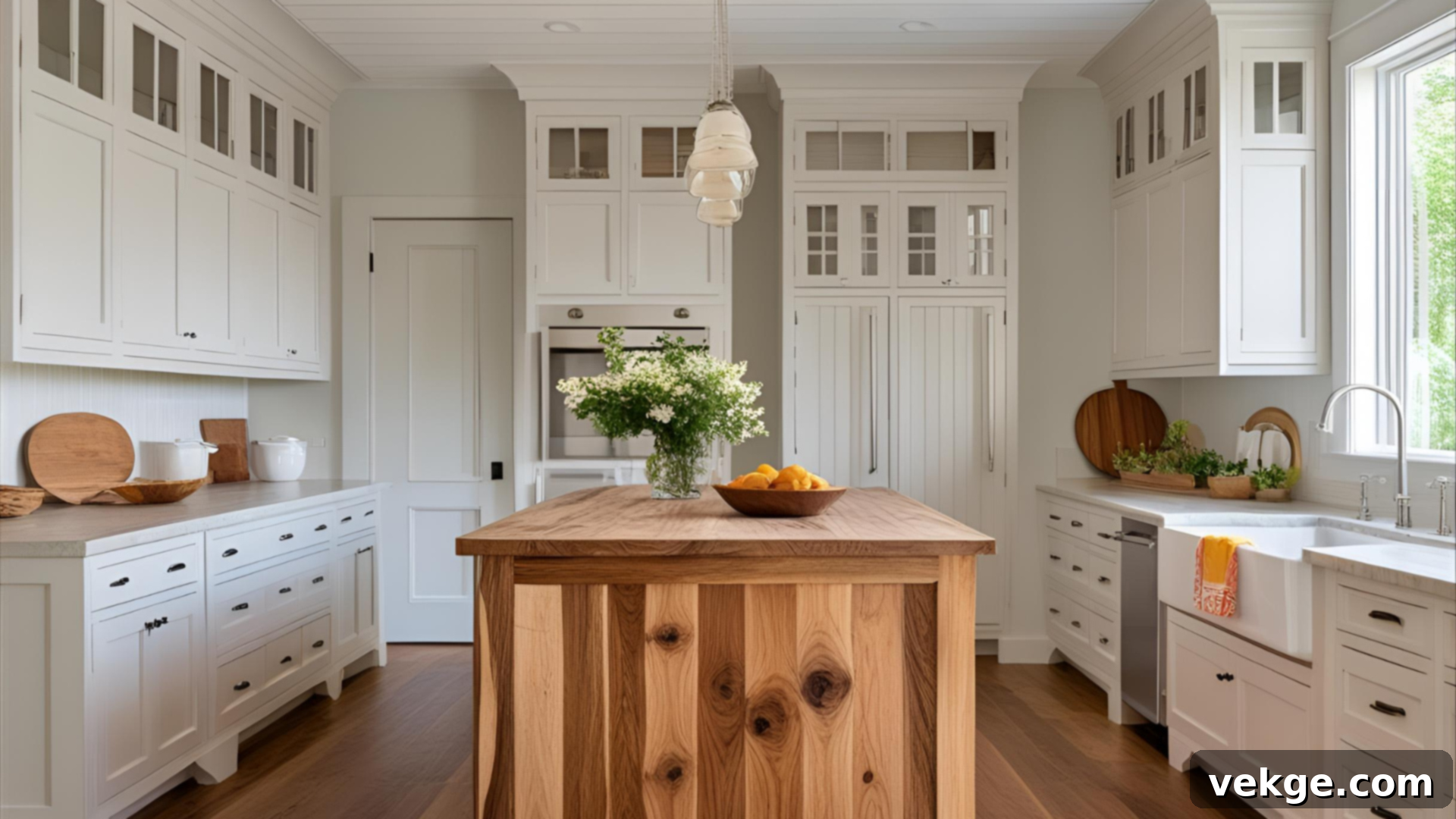
A natural wood island introduces essential warmth, rich texture, and a captivating grain contrast, serving as an inviting focal point in the heart of the kitchen. Surrounding this, painted perimeter cabinets provide a clean, consistent, and versatile foundation, allowing the wood to truly shine. This harmonious mix prevents the overall space from feeling overly sterile or monotonous, instead adding a thoughtful balance between organic elements and refined finishes. To ensure durability and longevity in a high-traffic area, always opt for a sealed wood finish on the island, protecting it from daily wear and spills while maintaining its natural beauty.
Design Tip: This is an excellent choice if you desire a low-gloss, tactile element and a touch of organic warmth at the center of your kitchen. It suits a range of styles from modern to transitional, especially when paired with complementary natural stone or white countertops.
Unique or Bold Combos
For those who dare to be different, these combinations push boundaries with unexpected yet captivating palettes.
21. Olive and Charcoal Cabinets
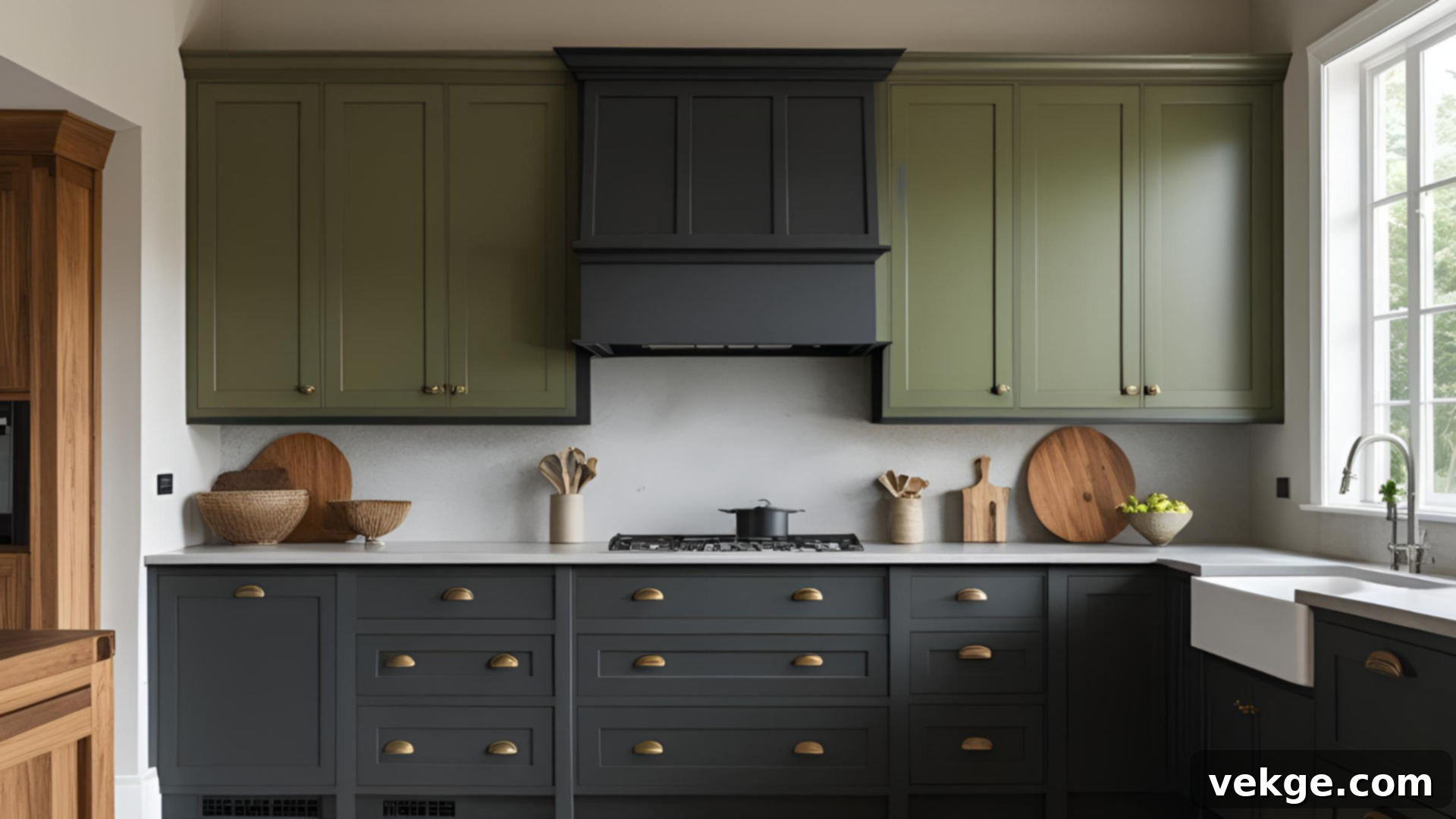
Olive base cabinets exude a rich, earthy, and sophisticated tone, grounding the kitchen with a unique organic feel. Meanwhile, charcoal uppers add a powerful, deeper grounding effect and a touch of urban chic. The overall combination feels robust and substantial without ever appearing harsh or overwhelming. This pairing is exceptionally well-suited for layering with other natural materials like reclaimed wood accents, rough-hewn stone countertops, or woven textures, creating a kitchen that feels deeply connected to nature and artisanal craftsmanship. It offers a unique departure from more common neutral palettes.
Design Tip: This bold duo is best utilized in kitchens with ample natural or well-designed artificial light, ensuring the darker charcoal tones do not overpower the room and that the olive’s richness can truly shine. Pair with warm metals like copper or antique brass.
22. Blush and Cream Cabinets
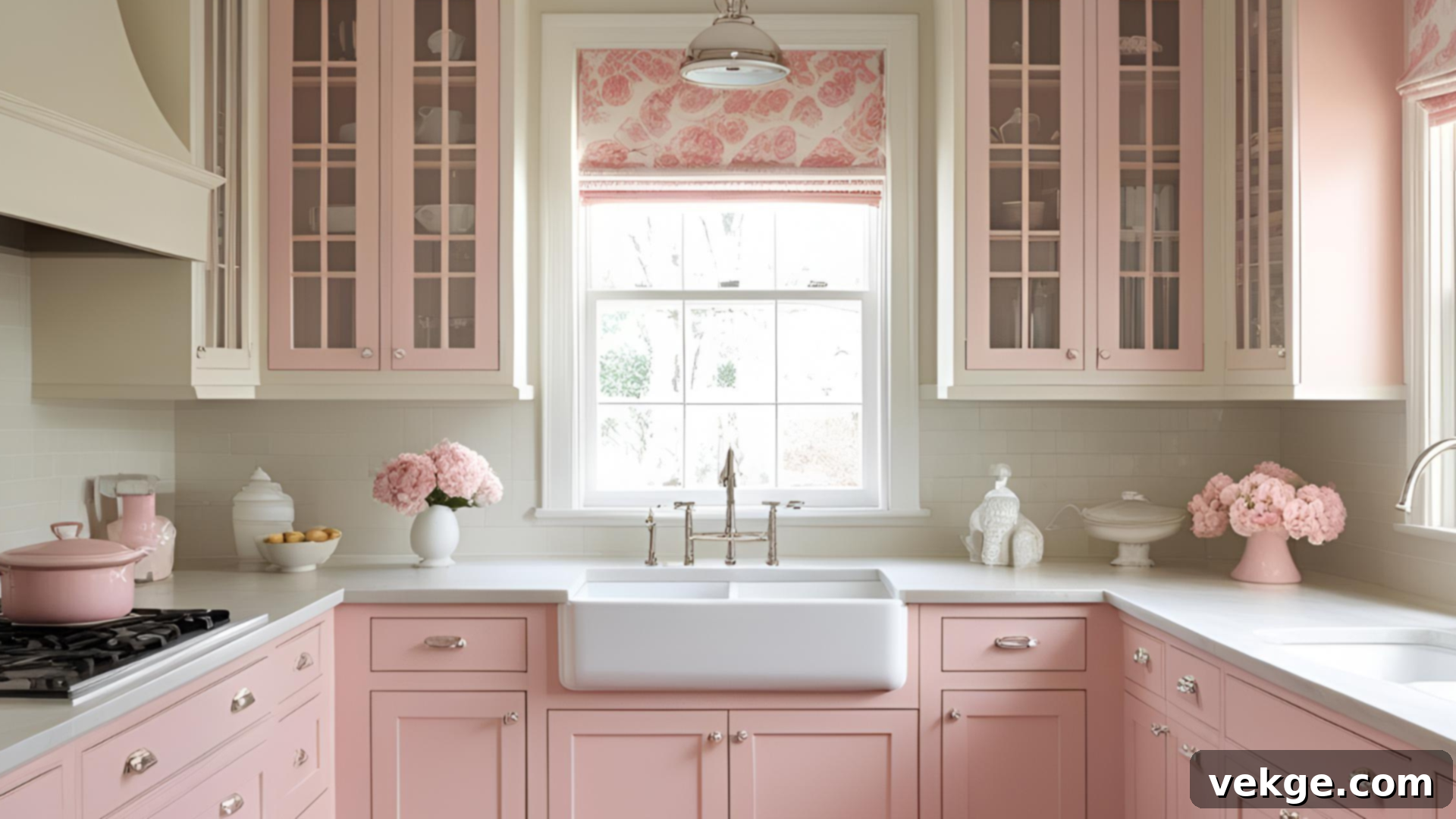
Blush lower cabinets introduce a delicate softness and a contemporary touch of subtle color, offering a gentle and inviting foundation for the kitchen. Cream uppers ensure the entire aesthetic remains beautifully balanced, preventing the blush from becoming overwhelming and maintaining an airy feel. The overall result is a kitchen that feels wonderfully warm and carefully controlled, exuding a sophisticated charm that is distinctly modern without being overtly feminine. This elegant look pairs exceptionally well with polished chrome or subtle brushed nickel fixtures, enhancing its refined appeal.
Design Tip: This combination is particularly effective in smaller kitchens or apartments where you desire a warm, personalized palette without venturing into overly bold or dark territory. Consider soft gold hardware for an extra layer of warmth.
23. Teal and Buttermilk Cabinets
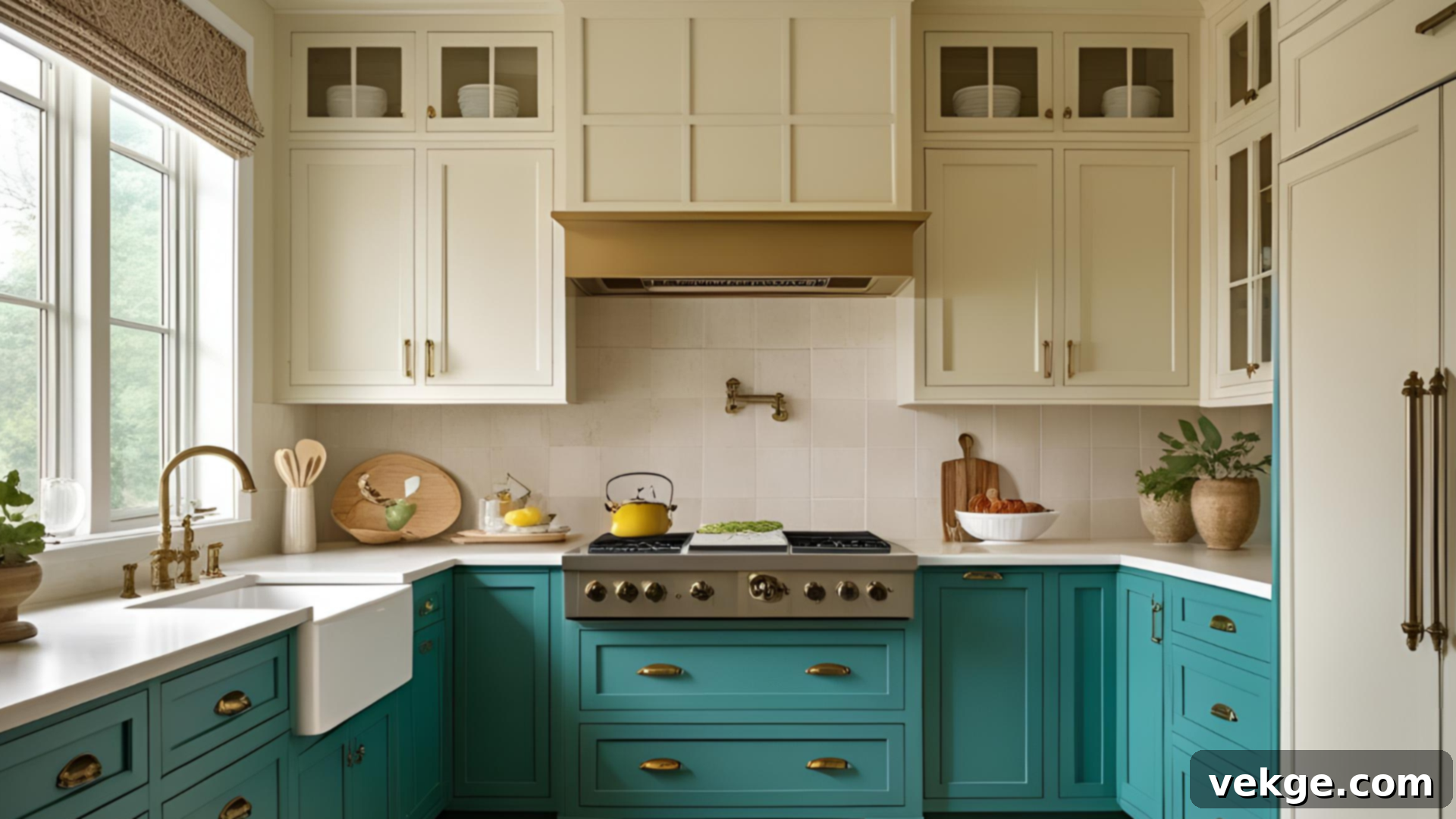
Teal cabinetry injects an invigorating sense of energy, vibrant personality, and profound depth into the kitchen, creating a truly captivating focal point. Buttermilk tones elegantly temper this boldness, tying into warm neutrals and ensuring the overall scheme remains harmonious and inviting. This distinctive setup integrates beautifully with both natural wood and classic tile floors, offering a versatile foundation for various design choices. Furthermore, this dynamic duo is robust enough to handle a bit more visual noise, allowing for playful backsplashes or open shelving displays without feeling cluttered.
Design Tip: This combination fits perfectly into vintage-inspired kitchens or those that artfully blend older and newer finishes, creating an eclectic yet cohesive aesthetic. Consider aged brass hardware for a touch of timeless charm.
24. Deep Red and Light Gray Cabinets
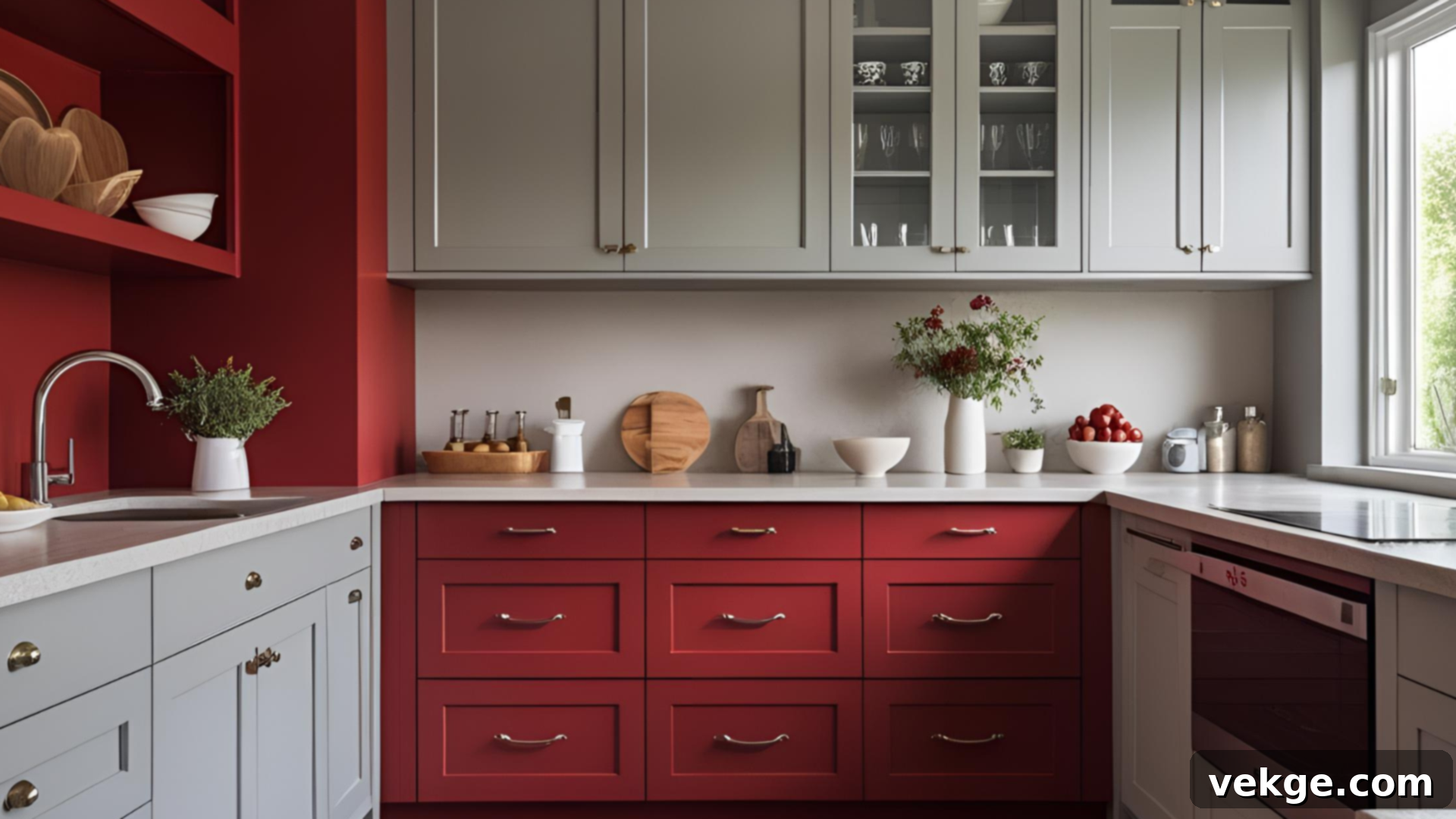
A rich, deep red on the base cabinets provides an undeniable focal point and a powerful statement of style, injecting warmth and personality into the kitchen’s foundation. Light gray uppers skillfully prevent the overall scheme from feeling too heavy or overwhelming, ensuring a sense of balance and openness. Together, they meticulously craft a layout that possesses clear definition and dynamic visual interest, while remaining sufficiently neutral to appeal for potential resale. The contrast is bold yet sophisticated, creating a memorable kitchen aesthetic that combines passion with practicality.
Design Tip: This striking combination is particularly effective when paired with dark countertops, such as honed black granite, or when complementing exposed brick accents, enhancing its rustic-industrial or contemporary appeal. Consider minimalist stainless steel hardware to let the colors shine.
25. Black and Tan Cabinets
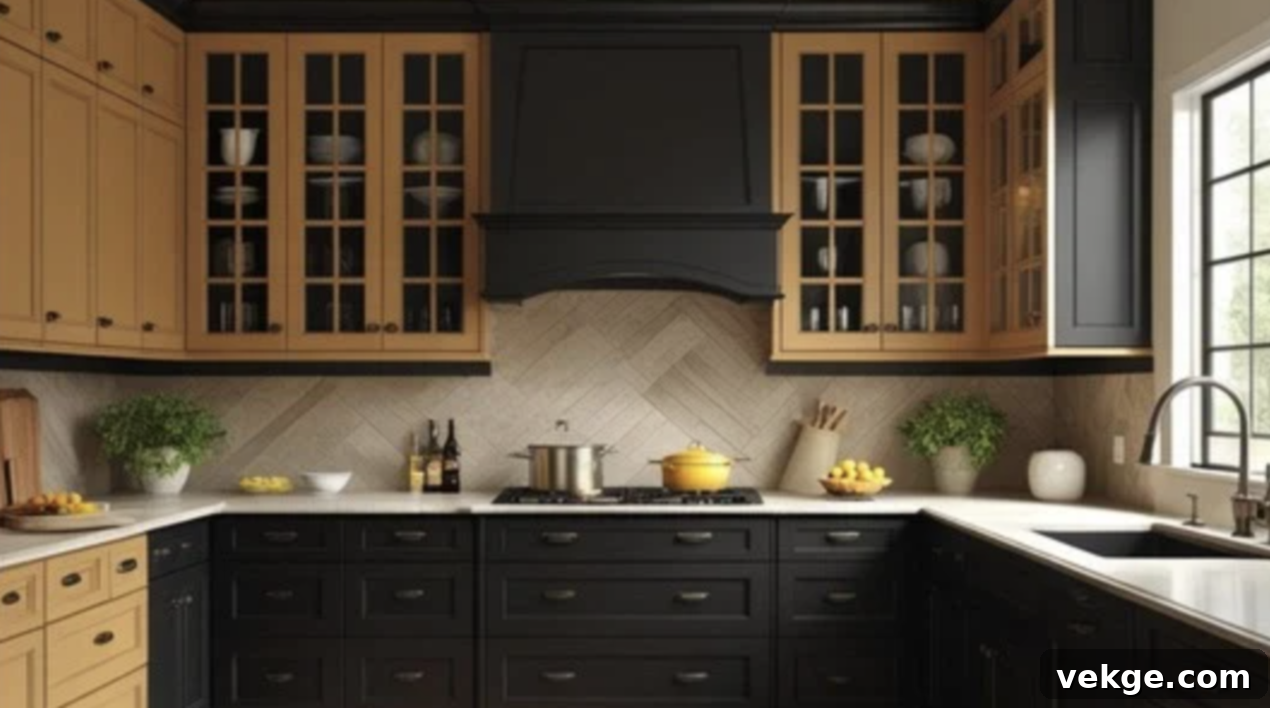
Black cabinets provide a strong, authoritative structure and an undeniable sense of modern sophistication, anchoring the kitchen with a bold foundation. Tan, with its inherent warmth and earthy undertones, offers a welcome relief from the potential starkness of black, softening the overall aesthetic and adding a cozy, inviting feel. This thoughtful layout makes the kitchen feel impeccably tailored and organized without introducing an overly sharp or jarring contrast. The combination is inherently balanced, offering a sophisticated neutral palette with depth and character.
Design Tip: This pairing is a remarkably practical choice for homes with active pets or those that experience heavy daily use, as both black and tan are excellent at concealing smudges, minor stains, and everyday wear, ensuring a consistently neat appearance. Consider matte black hardware or brushed bronze.
Small Kitchen Combos That Work Wonders
Maximize space and light in compact kitchens with these clever two-toned cabinet strategies.
26. White on Top, Warm Gray Below
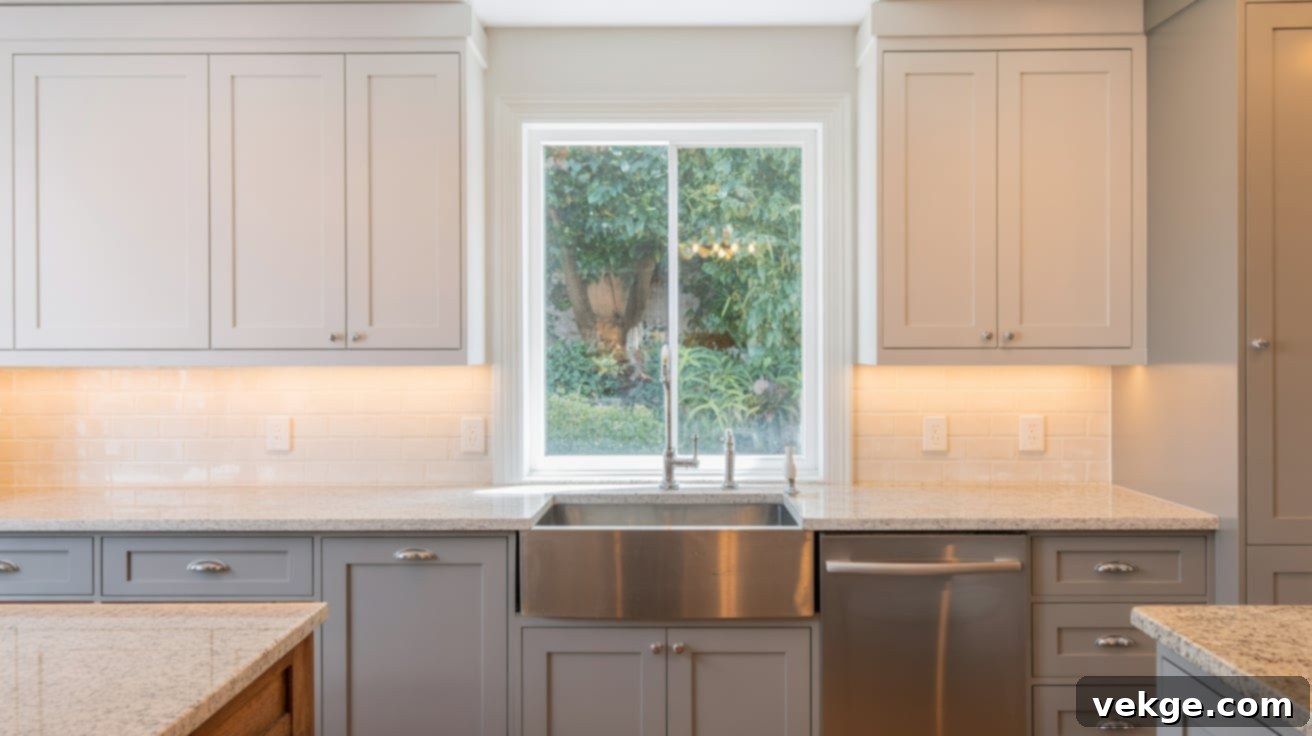
Crisp white upper cabinets effectively brighten the room, helping walls visually recede and creating an illusion of expanded space. Simultaneously, warm gray lower cabinets introduce a solid structure and a grounding base, preventing the kitchen from feeling too stark or clinical. This thoughtful balance imparts clarity and definition to the space without ever making it feel closed in or cramped. It stands as one of the safest yet most remarkably effective ways to introduce dynamic contrast without inadvertently shrinking the perception of a small kitchen. The warm undertones in the gray add an inviting touch.
Design Tip: This strategy is particularly advantageous when your kitchen has limited window light or if you are working with narrow galley or U-shaped floor plans, where visual expansion is crucial. Pair with reflective backsplashes for extra light diffusion.
27. Cream with Soft Blue Base
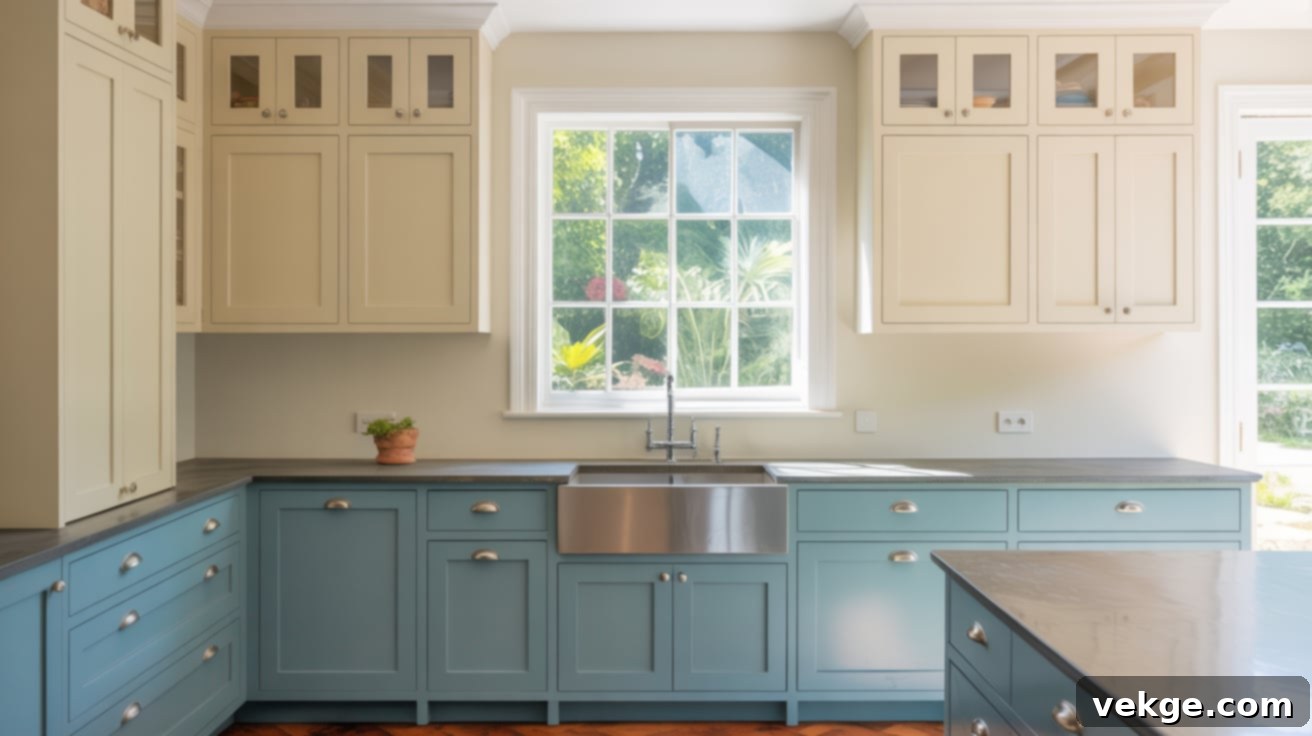
Cream uppers establish a clean, neutral, and wonderfully luminous frame, making the upper portion of the kitchen feel expansive and bright. In deliberate contrast, soft blue lower cabinets introduce a gentle, calming splash of color without ever being overtly loud or dominating the small space. This harmonious combination infuses the kitchen with a peaceful energy and effectively breaks any visual monotony in compact areas, creating subtle interest. The soft blue particularly shines when paired with white or beige flooring, creating a cohesive and serene environment that feels both sophisticated and inviting.
Design Tip: This is a superb choice for kitchens in older homes where light, airy tones can beautifully soften narrow walls and tight corners, adding charm and a sense of expanded space. Consider ceramic subway tile backsplashes for a classic touch.
28. Light Wood on Lowers, White on Uppers
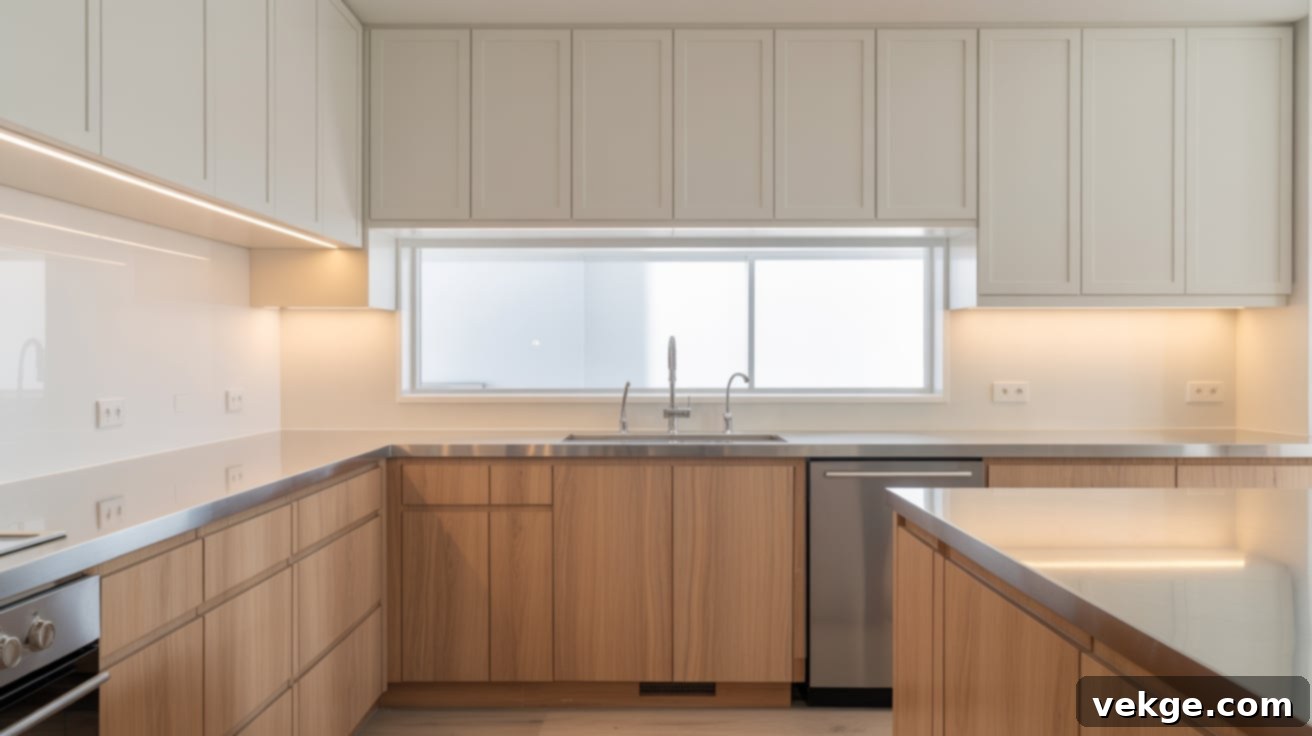
The pristine white cabinets positioned at eye level dramatically brighten the room, contributing to an expansive and airy feel. Simultaneously, the light wood below introduces essential warmth, subtle texture, and an organic element to the lower portion of the kitchen. This clever setup masterfully creates the illusion of taller ceilings by drawing the eye upwards, making it perfect for vertically challenged spaces. The natural, understated tones of the light wood also ensure effortless blending with a wide array of flooring choices, from light tiles to darker hardwoods, making design coordination simpler and more fluid.
Design Tip: This combination is ideal for low-ceiling kitchens or apartments with limited vertical space, as it visually elongates the room. Consider sleek, handleless doors for an even more streamlined and modern aesthetic.
29. Pale Green Base with Open Shelves

Pale green lower cabinets introduce a subtle yet refreshing pop of color and an organic, calming vibe to the base of the kitchen. Above, strategically placed open shelving replaces traditional upper cabinets, dramatically removing visual bulk and fostering an immediate sense of openness and airiness. This thoughtful design choice prevents small kitchens from feeling cramped or enclosed, instead making them appear wider and more breathable. It represents a smart and stylish way to avoid visually crowding your top wall space, perfect for showcasing decorative items or frequently used dishware.
Design Tip: This setup works exceptionally well in kitchens that feature only one main wall for cabinetry or when conventional upper cabinets would obstruct valuable natural light, ensuring the space remains bright and inviting.
30. Navy Base with Floating White Cabinets
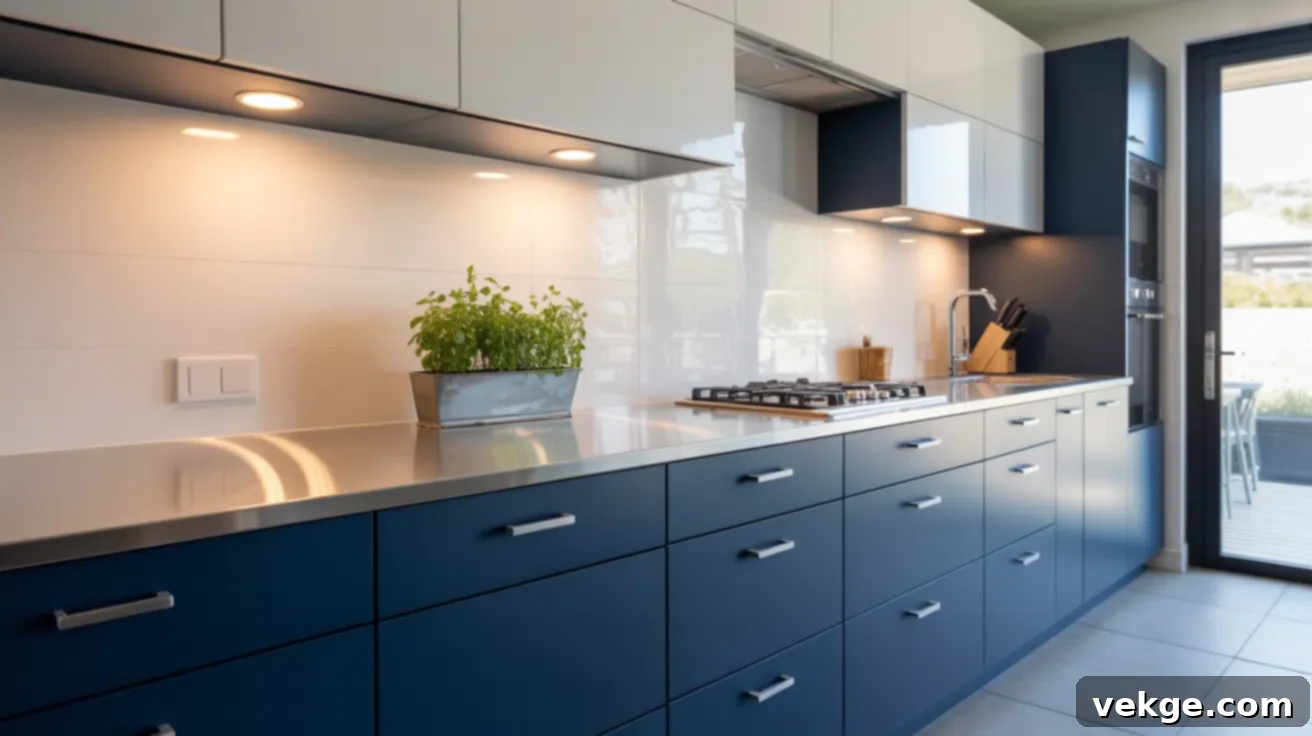
Deep navy provides sophisticated depth and a strong anchor at the base of the kitchen, creating a bold, grounded foundation. In striking contrast, floating white uppers meticulously lighten the visual load and dramatically enhance the sense of openness and modern elegance. The deliberate separation between the navy base and the seemingly suspended white cabinets creates a powerful and dynamic contrast without visually enclosing the space. Furthermore, navy cabinetry is renowned for its durability and ability to gracefully withstand the demands of high-use areas, making it a practical choice for busy households.
Design Tip: This modern design is ideally suited for studio or loft kitchens, or any space where wall space is at a premium and multifunctional layouts are essential, offering both style and efficient use of vertical space. Pair with minimalist hardware or integrated pulls.
31. Dark Gray Island in a Compact Layout
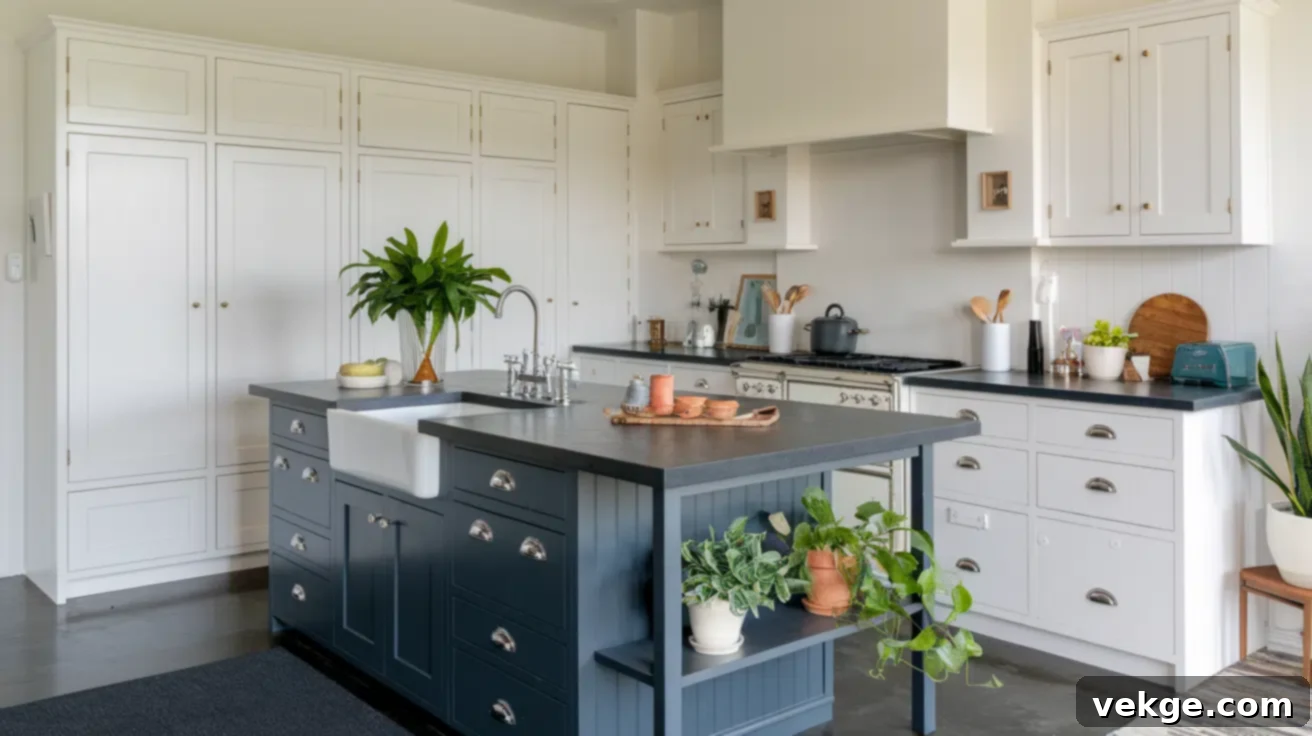
Even within the constraints of a compact layout, a dark gray island can effectively add significant visual structure and a sophisticated focal point to an open-plan kitchen. Its presence subtly but clearly defines distinct prep and storage zones without visually consuming the precious space. When thoughtfully paired with neutral surrounding cabinets, such as white, light gray, or cream, the dark gray island blends smoothly into the overall design, creating a cohesive and well-organized environment. It’s a clever way to introduce a central element without sacrificing the perception of space.
Design Tip: This approach is highly effective when your kitchen seamlessly doubles as a dining or work area, providing necessary functional separation without making the overall space feel cramped or overburdened. Consider a light-colored countertop on the island for contrast.
How to Pick a Two-Toned Color Combination That Works in Your Home
Choosing the perfect two-toned cabinet colors requires a thoughtful consideration of your kitchen’s unique characteristics, including its layout, existing materials, and lighting conditions. The key is to keep it simple, balanced, and supremely practical for long-term enjoyment and enduring style.
1. Match Your Cabinets to Existing Countertops and Flooring
The selected cabinet colors must harmonize with your existing surfaces to prevent visual clutter and ensure a cohesive aesthetic. Carefully examine the undertones in your flooring and countertops – are they warm (yellow, red, orange-based) or cool (blue, green, purple-based)? Choose cabinet colors that either seamlessly blend with these undertones or offer a deliberate, striking contrast that is intentional and well-executed. Avoid combining warm and cool tones haphazardly without a clear design strategy, as this can often lead to a disjointed and aesthetically unpleasing result. If you are embarking on a full kitchen remodel, make the strategic decision to select one major surface first (e.g., a statement countertop or unique flooring) and then build your subsequent color decisions around this foundational element for a truly integrated look.
2. Use Lighting to Inform Your Contrast Choices
Both natural and artificial lighting play a pivotal role in how colors are perceived and can dramatically shift the mood of your kitchen. In kitchens with limited natural light, it is generally advisable to avoid pairing two dark tones, as this can inadvertently make the room feel much smaller, heavier, and potentially oppressive. Brighter, more generously lit spaces, conversely, can comfortably accommodate deeper and more dramatic contrasts, allowing rich colors to truly flourish without overwhelming. Always test paint samples directly in your kitchen under both daytime and evening lighting conditions to ensure the chosen hues maintain their appeal and work harmoniously throughout the day. Strategic under-cabinet lighting can also be utilized to beautifully highlight tone shifts and add an inviting glow, further enhancing the two-tone effect.
3. Start With a Neutral and Add One Deeper Shade
To ensure your two-tone kitchen design remains balanced, sophisticated, and universally appealing, begin with a reliable and expansive neutral base color. Excellent choices include classic white, creamy ivory, or a versatile light gray. Once your neutral foundation is established, introduce a single, carefully selected darker or richer shade. This accent color is most effectively applied to your base cabinets, a prominent kitchen island, or specific accent sections like a coffee bar or pantry. This layered approach not only keeps the entire room visually grounded but also imbues it with essential definition, character, and a sense of thoughtful design. Utilizing two equally bold or vibrant tones rarely achieves a cohesive look unless the rest of your space is exceptionally minimalist and consistent, risking a chaotic appearance.
Planning Tips for a Flawless Two-Tone Kitchen Layout
To truly maximize the aesthetic and functional potential of a two-tone cabinet setup, adhere to these key design principles: aim for clean layouts, meticulously avoid visual clutter, and ensure all tones are thoughtfully coordinated.
- Wall Uppers with Base Cabinet Contrast: This is arguably the most classic and universally appealing two-tone approach. Utilize lighter-colored uppers to visually elevate and brighten the room, making it feel more expansive and airy. Simultaneously, darker lower cabinets will effectively anchor the layout, providing a sense of stability and depth. This creates a beautifully balanced and incredibly space-friendly option, especially beneficial for kitchens of any size.
- Island as the Second Tone: Designating your kitchen island as the second, contrasting tone is an excellent strategy, particularly for open-concept kitchens or larger layouts. A distinct island color adds clear separation and acts as a dynamic focal point without overwhelming the surrounding space. It defines the workspace and often becomes the heart of the kitchen’s social hub.
- Accent Sections Only (Coffee Bar, Pantry, Hutch): If you’re hesitant to commit to a full two-tone scheme, or simply wish to add subtle intrigue, apply your second color to a smaller, dedicated area. A coffee bar, a built-in pantry, or an elegant hutch can benefit immensely from a contrasting tone, breaking the visual repetition of uniform cabinetry without overdoing it. This method creates purposeful visual interest and unique zones.
- Avoid Using More Than Two Tones: While creativity is encouraged, introducing more than two primary colors or distinct finishes for your cabinetry can quickly make the space appear cluttered, chaotic, and unfocused. This effect is particularly pronounced in smaller kitchens, where simplicity is key to maintaining an open and airy feel. Stick to a dominant primary and a well-chosen secondary color for maximum impact and harmony.
- Avoid Clashing Undertones (Warm vs. Cool): Harmony in color schemes often stems from understanding undertones. Mixing warm-toned cabinets (e.g., creamy white, beige, brown wood) with cool-toned elements (e.g., crisp white, blue-gray, cool gray countertops) without careful consideration can result in a mismatched or unplanned look. Always ensure your chosen colors share similar undertones (all warm or all cool) or deliberately choose a neutral that bridges both, to maintain a cohesive and sophisticated palette.
- Avoid Combining Glossy and Matte Finishes Without Balance: While mixing sheens can add a layer of sophistication, it must be done with intention and balance. An unbalanced combination of high-gloss and matte finishes can create inconsistent reflections, distract the eye, and make the layout feel disjointed. For instance, matte lower cabinets can offer durability and a grounded feel, while glossy uppers can reflect light and add a modern touch, but ensure the overall proportion and distribution of these finishes are carefully considered to achieve a refined aesthetic.
Conclusion
If you’ve been contemplating the transformative potential of two-toned kitchen cabinets, we sincerely hope this comprehensive guide has provided you with a wealth of clear, inspiring ideas and actionable strategies. Embracing this versatile design trend doesn’t require a commitment to overly bold colors or intricately complicated layouts; often, just the right thoughtful mix of complementary tones is all it takes to bestow your space with renewed structure, sophisticated style, and enhanced personality.
Remember to carefully consider how existing elements like your kitchen’s unique lighting, flooring, and overall layout seamlessly work together when making your selections. If you’re still feeling uncertain or wish to dip your toes in, consider starting with a small accent section or a contrasting island to visualize the effect. The true beauty of two-toned cabinetry lies in its adaptability—it’s a wonderfully versatile trend that integrates beautifully across a diverse range of kitchen types and design aesthetics, from the ultra-modern to the charmingly traditional.
Keep experimenting with confidence, and trust your instincts; you’re sure to discover a combination that not only suits your home perfectly but also brings you immense joy every time you step into your revitalized kitchen. For even more insightful layout ideas and clever kitchen tips to inspire your next home project, be sure to explore our other engaging blogs. There’s plenty more design wisdom where this came from!
